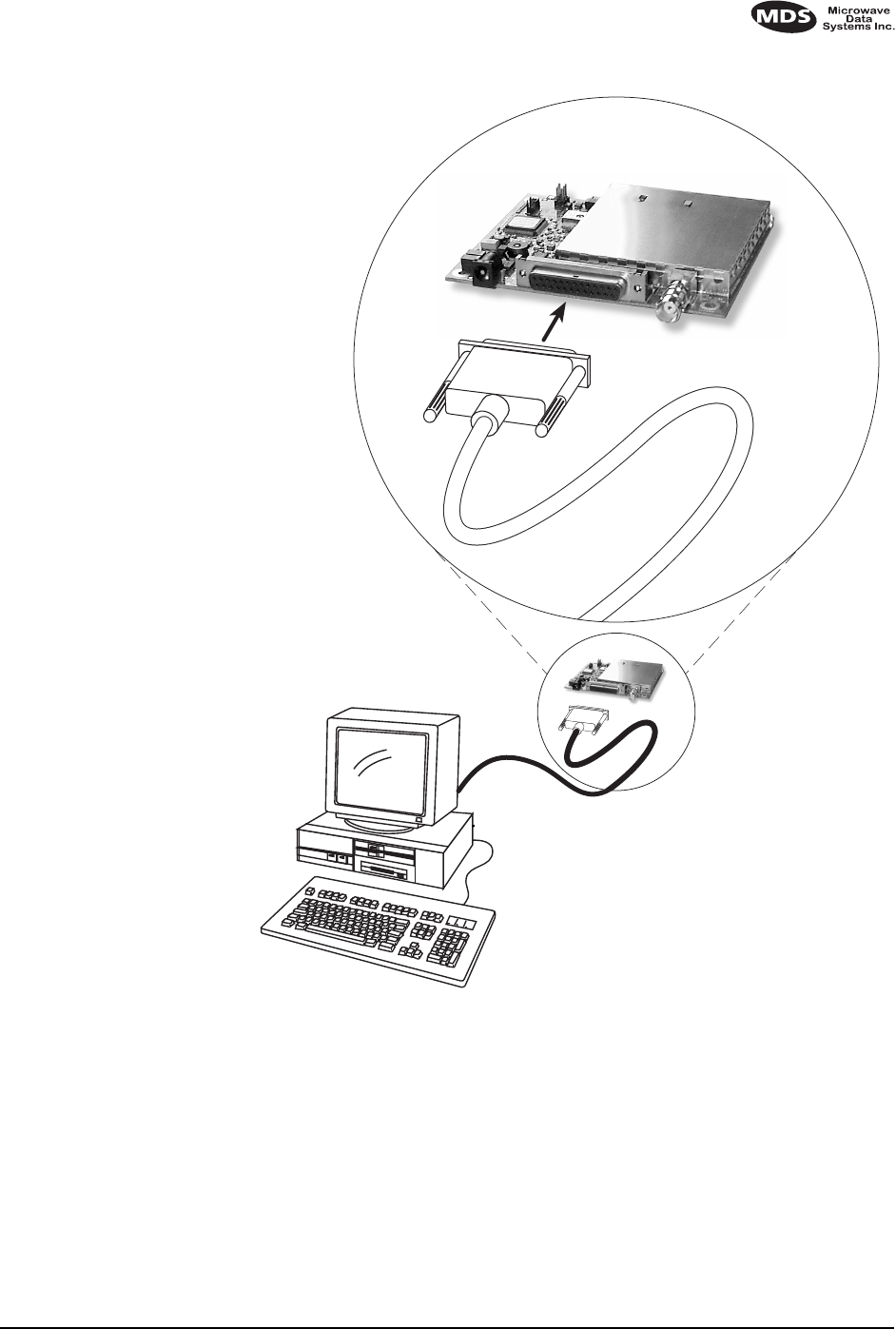GE MDS DS-EL705-9 EL705 OEM Series Radio User Manual OEM 900 Series Body
GE MDS LLC EL705 OEM Series Radio OEM 900 Series Body
GE MDS >
Contents
- 1. Operating Instructions Part 1 of 2
- 2. Operating Instructions Part 2 of 2
Operating Instructions Part 2 of 2
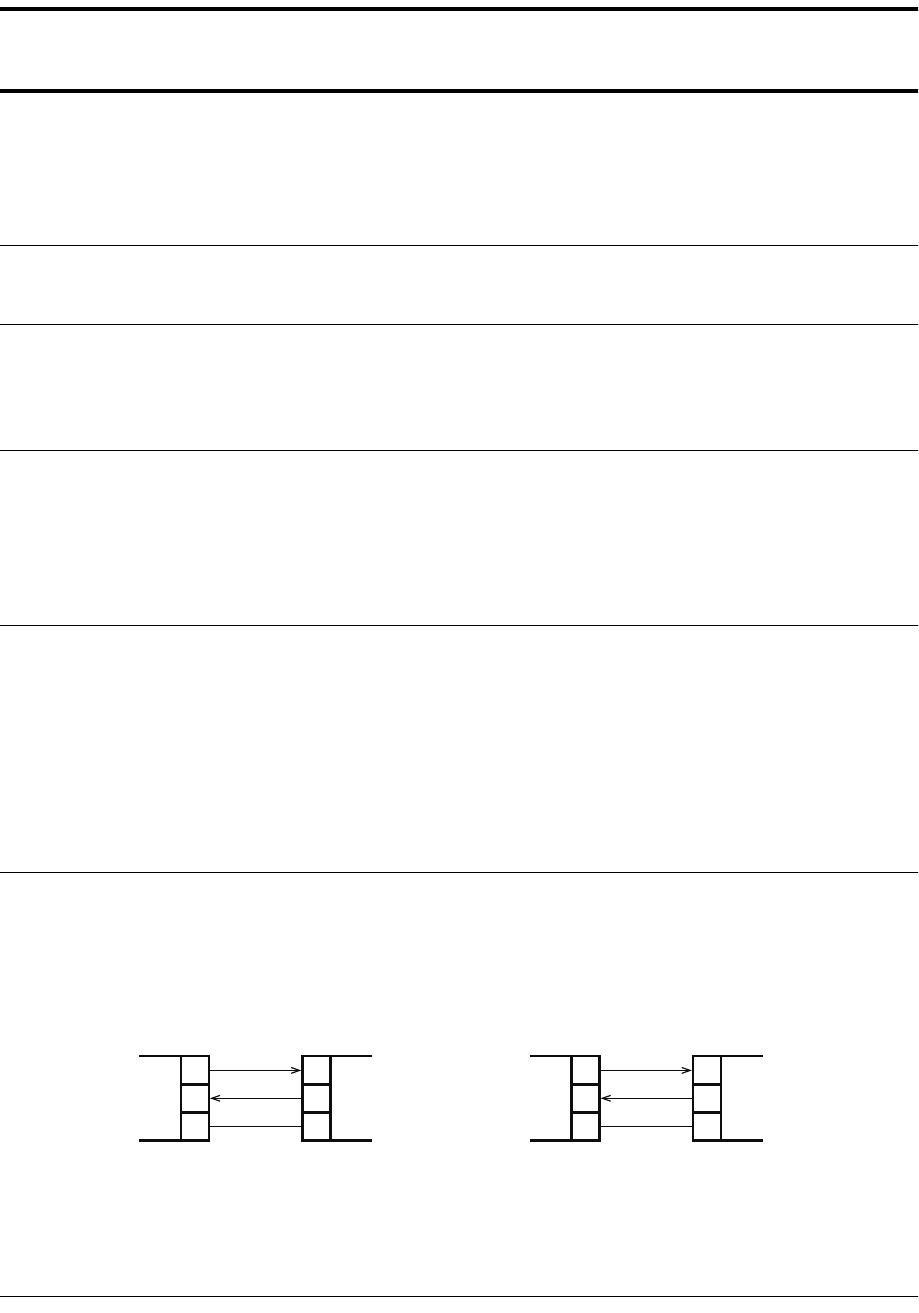
QUICK START GUIDE
Below are the basic steps for installing the transceiver. Detailed instructions are given in “Installation
Steps” on page 6 of this guide.
1. Mount the transceiver (see
Figure 6
or
Figure 7
for mounting dimensions)
2. Install and connect the antenna system to the radio
• Use only good quality, low loss coaxial cable. Keep the feedline as short as possible.
• Preset directional antennas in the direction of desired transmission/reception.
3. Apply DC power to the radio (10–16 Vdc @ 2 A minimum)
• Measure the voltage source before connection.
• Observe proper polarity.
• Connect power to the power connector.
4. Set the radio’s basic configuration with a terminal (PC or HHT) connected to
the
INTERFACE
port
• Pin 23 of the INTERFACE port must be grounded to place the radio in the control and programming
mode. (See
Figure 12 on page 16
for a cable wiring diagram.)
• Set the transmit frequency (
TX xxx.xxx
).
• Set the receive frequency (
RX xxx.xxx
).
• Set the network address (
ADDR xxx
). All radios in a given network must have the same address.
• Set/verify the data rate using the
BAUD
command. The default setting is
BAUD 9600 8N1
. (Refer to
“TRANSCEIVER PROGRAMMING” on page 14 for command details.)
5. Connect the data equipment to the radio’s INTERFACE connector
• Connection to the radio must be made with a DB-25 Male connector. Connections for typical sys-
tems are shown below.
• Connect only the required pins. Do not use a straight-through RS-232 cable with all pins wired.
• Verify the data equipment is configured as DTE. (By default, the radio is configured as DCE.)
6. Verify proper operation by observing the LED display
• See Table 5 on page 13 for a description of the status LEDs.
• Refine directional antenna headings for maximum receive signal strength using the
RSSI
command.
DB-25 DB-25
TRANSCEIVER
(DCE)
RTU
(DTE)
DB-9 DB-25
DB-9 to DB-25 ExampleDB-25 to DB-25 Example
2
3
2
3
TXD
RXD
TXD
RXD
GND GND
77
TRANSCEIVER
(DCE)
RTU
(DTE)
NOTE: Additional connections may be
needed in some installations.
See Installation for details.
2
3
3
2
RXD
TXD
RXD
TXD
GND GND
57

MDS 05-3624A01, Rev. B OEM Series I/O Guide i
TABLE OF CONTENTS
1.0 INTRODUCTION .........................................................................1
1.1 Differences Among Models ..............................................................1
Modem Speeds ..................................................................................2
Frequency Coverage ..........................................................................2
1.2 Applications ......................................................................................2
Point-to-Multipoint, Multiple Address Systems (MAS) ........................2
Point-to-Point System .........................................................................3
Switched Carrier Operation ................................................................4
Single Frequency (Simplex) Operation...............................................4
1.3 Model Number Codes ......................................................................4
1.4 Accessories ......................................................................................5
2.0 INSTALLATION ............................................................................6
2.1 Installation Steps ..............................................................................6
2.2 Mounting the Transceiver .................................................................8
Transceiver Board...............................................................................8
Enclosed Transceiver..........................................................................8
2.3 Antennas and Feedlines ..................................................................9
Antennas ............................................................................................9
Feedlines ............................................................................................9
2.4 Power Connection ..........................................................................10
Conservation (Sleep Mode)..............................................................10
2.5 Data Interface Connections ............................................................10
3.0 OPERATION..............................................................................13
3.1 Initial Startup ..................................................................................13
3.2 LED Indicators ................................................................................13
4.0 TRANSCEIVER PROGRAMMING ............................................14
4.1 Radio Programming Methods ........................................................14
PC with Radio Configuration Software ..........................................14
À PC in Terminal Mode....................................................................14
à Handheld Terminal (HHT).............................................................14
4.2 PC Connection and Startup ...........................................................14
4.3 Keyboard Commands .....................................................................16
Entering Commands.........................................................................16
Error Messages ................................................................................16
4.4 Detailed Command Descriptions ...................................................18
ADDR [NONE | 1–255] .....................................................................18
AMASK [0000 0000–FFFF FFFF] ....................................................18
BAUD [xxxxx abc] .............................................................................19
CTS [0–255] .....................................................................................19
CTSHOLD [0–60000] .......................................................................19

ii OEM Series I/O Guide MDS 05-3624A01, Rev. B
DEVICE [DCE | CTS KEY] ...............................................................20
DKEY................................................................................................20
INIT...................................................................................................20
KEY ..................................................................................................21
OWM [XXX...] ...................................................................................21
OWN [XXX...]....................................................................................21
PWR [L | M | H].................................................................................21
RSSI and RSSI!................................................................................22
RX [xxx.xxx]......................................................................................22
RXTOT [NONE | 1–255] ...................................................................22
SER ..................................................................................................22
SREV................................................................................................22
STAT .................................................................................................22
TOT [1–255 | ON | OFF] ...................................................................23
TX [xxx.xxx] ......................................................................................23
5.0 TROUBLESHOOTING...............................................................24
5.1 LED Indicators ................................................................................24
5.2 Event Codes ...................................................................................24
Checking for Alarms—STAT command.............................................24
Major Alarms vs. Minor Alarms.........................................................25
Event Code Definitions .....................................................................25
6.0 TECHNICAL REFERENCE .......................................................26
6.1 OEM Series™ Transceiver Specifications ......................................26
6.2 Bench Testing Setup ......................................................................27
6.3 Helical Filter Adjustment ................................................................28
6.4 Upgrading the Radio’s Software .....................................................29
Using Radio Configuration Software.................................................30
6.5 dBm-Watts-Volts Conversion Chart ................................................31
7.0 GLOSSARY OF TERMS............................................................32
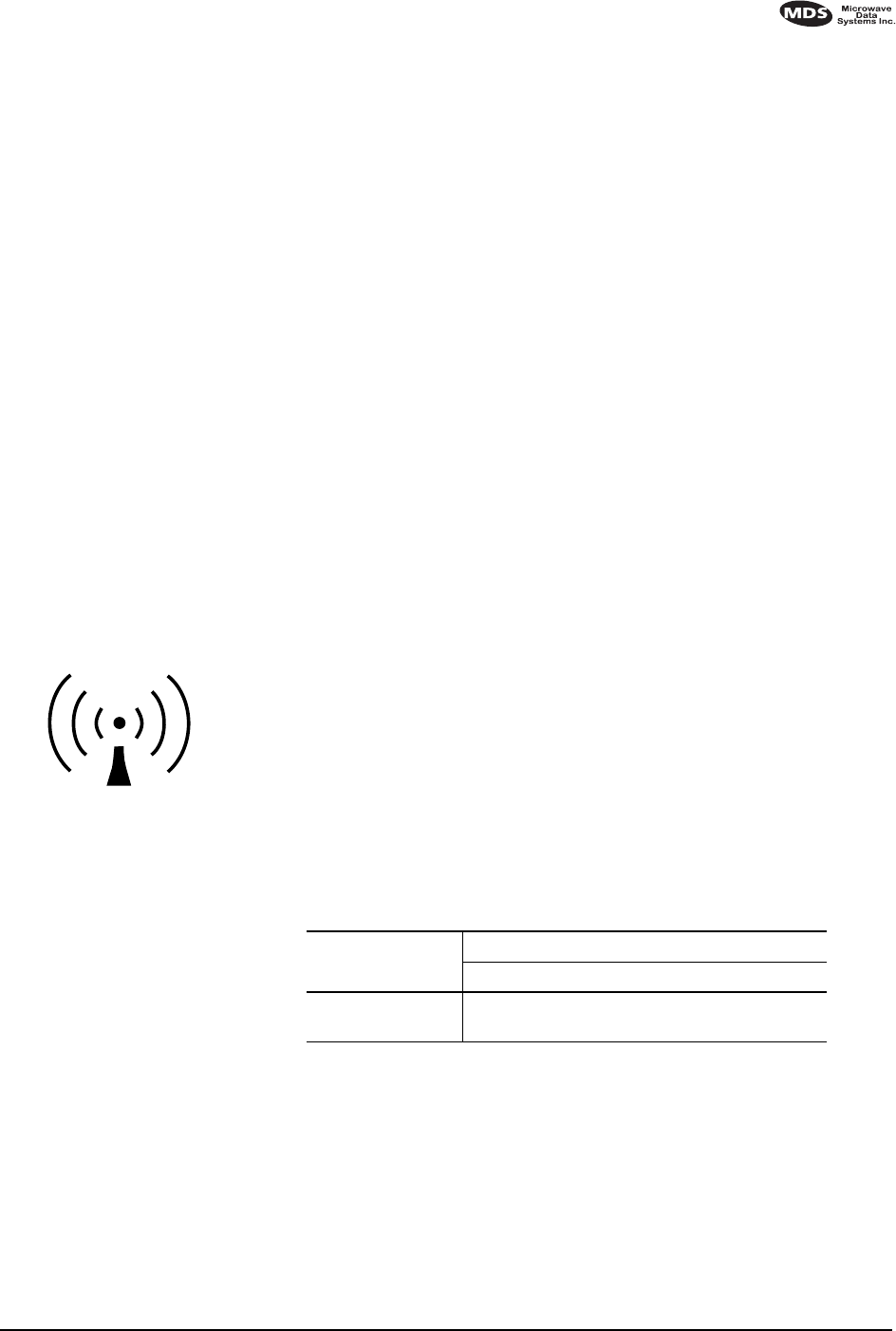
MDS 05-3624A01, Rev. B OEM Series I/O Guide iii
Copyright Notice
This Installation and Operation Guide and all software described herein
are protected by
copyright: 2001 Microwave Data Systems Inc
. All
rights reserved.
Microwave Data Systems Inc. reserves its right to correct any errors and
omissions in this publication.
Antenna Installation Warning
1. All antenna installation and servicing is to be performed by
qualified technical personnel
only. When servicing the antenna, or
working at distances closer than those listed below,
ensure the
transmitter has been disabled.
Output is measured at the antenna terminal of the transmitter. The
antenna(s) used for this transmitter must be fixed-mounted on
outdoor permanent structures to provide the minimum separation
distances described in this filing for satisfying RF exposure
compliance requirements. When applicable, RF exposure
compliance may need to be addressed at the time of licensing, as
required by the responsible FCC Bureau(s), including antenna
co-location requirements of section 1.1307(b)(3).
2. Typically, the antenna connected to the transmitter is a directional
(high gain) antenna, fixed-mounted on the side or top of a building,
or on a tower. Depending upon the application and the gain of the
antenna, the total composite power could exceed 90 watts EIRP. The
antenna location should be such that only qualified technical per-
sonnel can access it, and that under normal operating conditions no
other person can touch the antenna or approach within
2.3 meters
of
the antenna.
ISO 9001 Registration
Microwave Data Systems adheres to this internationally accepted
quality system standard.
RF Exposure
Separation distances
required for FCC RF
Exposure compliance
Antenna Gain vs. Recommended Safety Distance
(EL705 OEM 900 Series)
Antenna Gain (EL705 OEMSeries)
0–5 dBi 5–10 dBi 10–18.65 dBi
Minimum RF
Safety Distance
0.53 meter 0.94 meter 2.58 meters

iv OEM Series I/O Guide MDS 05-3624A01, Rev. B
MDS Quality Policy Statement
We, the employees of Microwave Data Systems Inc., are committed to
understanding and exceeding our customer’s needs and expectations.
•We appreciate our customer’s patronage. They are our business.
•We promise to serve them and anticipate their needs.
•We are committed to providing solutions that are cost effective,
innovative and reliable, with consistently high levels of quality.
•We are committed to the continuous improvement of all of our
systems and processes, to improve product quality and increase
customer satisfaction.
FM/UL/CSA Notice
This product is available for use in Class I, Division 2, Groups A, B,
C & D Hazardous Locations. Such locations are defined in Article 500
of the National Fire Protection Association (NFPA) publication NFPA
70, otherwise known as the National Electrical Code.
The transceiver has been recognized for use in these hazardous locations
by three independent agencies —Underwriters Laboratories (UL), Fac-
tory Mutual Research Corporation (FMRC) and the Canadian Standards
Association (CSA). The UL certification for the transceiver is as a Rec-
ognized Component for use in these hazardous locations, in accordance
with UL Standard 1604. The FMRC Approval is in accordance with
FMRC Standard 3611. The CSA Certification is in accordance with
CSA STD C22.2 No. 213-M1987.
FM/UL/CSA Conditions of Approval:
The transceiver is not acceptable as a stand-alone unit for use in the haz-
ardous locations described above. It must either be mounted within
another piece of equipment which is certified for hazardous locations, or
installed within guidelines, or conditions of approval, as set forth by the
approving agencies. These conditions of approval are as follows:
1. The transceiver must be mounted within a separate enclosure which
is suitable for the intended application.
2. The antenna feedline, DC power cable and interface cable must be
routed through conduit in accordance with the National Electrical
Code.
3. Installation, operation and maintenance of the transceiver should be
in accordance with the transceiver's installation manual, and the
National Electrical Code.
4. Tampering or replacement with non-factory components may
adversely affect the safe use of the transceiver in hazardous loca-
tions, and may void the approval.

MDS 05-3624A01, Rev. B OEM Series I/O Guide v
5. When installed in a Class I, Div. 2, Groups A, B, C or D hazardous
location, observe the following:
WARNING —EXPLOSION HAZARD—
Do not disconnect
equipment unless power has been switched off or the area is known
to be non-hazardous.
Refer to Articles 500 through 502 of the National Electrical Code
(NFPA 70) for further information on hazardous locations and approved
Division 2 wiring methods.
ESD Notice
(Board version only)
To prevent malfunction or damage to this product, which may be caused
by Electrostatic Discharge (ESD), the radio should be properly
grounded at the time of installation. In addition, the installer or main-
tainer should follow proper ESD precautions, such as touching a bare
metal object to dissapate body charge, prior to touching components or
connecting/disconnecting cables.
Cable Length Recomendation
MDS recommends a maximum cable length of 3.0 meters for
DC power
and
data
connections to this product.
Revision Notice
While every reasonable effort has been made to ensure the accuracy of
this manual, product improvements may result in minor differences
between the manual and the product shipped to you. If you have addi-
tional questions or need an exact specification for a product, please con-
tact our Customer Service Team using the information at the back of this
guide. In addition, manual updates can often be found on the MDS Web
site at
www.microwavedata.com
.

vi OEM Series I/O Guide MDS 05-3624A01, Rev. B
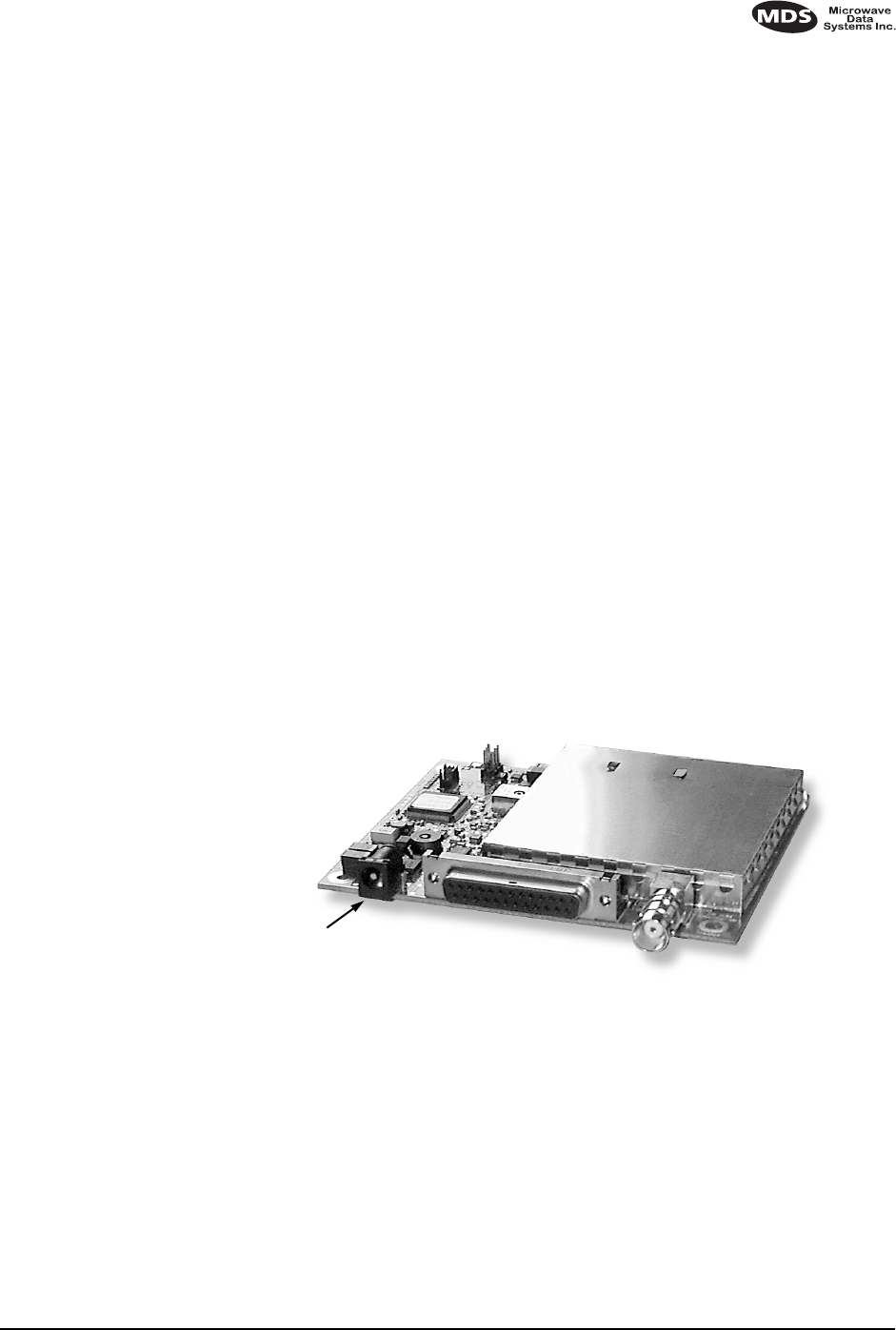
MDS 05-3624A01, Rev. B OEM Series™ I/O Guide 1
1.0 INTRODUCTION
This guide presents installation and operating instructions for the MDS
OEM Series™ of radio transceivers. The radios can be purchased as
compact, modular boards for direct mounting inside remote terminal
units (RTUs), programmable logic controllers (PLCs), automatic
teller/banking machines, or similar equipment. They are also available
as standalone units packaged in their own enclosures (see lower cover
illustration).
Although this manual focuses on the board-level product, the operating
specifications and user connections are identical for both versions of the
radio. Only the visual appearance and mounting details differ between
the two. These differences are explained in the text where necessary.
The transceiver (Figure 1) is a data telemetry radio designed to operate
in a point-to-multipoint environment, such as electric utility
Supervisory Control and Data Acquisition (SCADA) and distribution
automation, gas field automation, water and wastewater SCADA, and
on-line transaction processing applications. The radio employs
microprocessor control to provide highly reliable communications, even
under adverse conditions.
MDS OEM Series™ radios use continuous-phase frequency shift
keying (CPFSK) modulation with a 4-level modem.
Invisible place holder
Figure 1. OEM Series™ Series Data Transceiver
(Board version shown—enclosed unit similar)
1.1 Differences Among Models
All OEM Series™ models are very similar in appearance and
functionality. The major differences are over-the-air modem speed and
frequency coverage.
NOTE: FINAL DESIGN WILL EMPLOY
A TWO-PIN, POLARIZED POWER
CONNECTOR.

2 OEM Series™ I/O Guide MDS 05-3624A01, Rev. B
Modem Speeds
Two modem speeds are available in the OEM 900 transceiver—
standard 9600, and an optional 4800 bps. The latter provides 3 dB of
extra receive sensitivity where greater range is required.
Changing the modem speed requires loading different software into the
radio using MDS’ Radio Configuration Software. See
Radio
Programming Methods
on Page 14 for more information.
Frequency Coverage
The OEM 900 Series radio operates in the 900 MHz frequency band.
The exact frequency coverage of each model is listed in the
Specifications chart on Page 26.
NOTE:
The radio’s frequency range (band) cannot be set or changed
by the user; it is set at the factory.
1.2 Applications
Point-to-Multipoint, Multiple Address Systems (MAS)
Point-to-multipoint (MAS) is the most common application of the
transceiver. It consists of a central master station and several associated
remote units as shown in Figure 2. An MAS network provides
communications between a central host computer and remote terminal
units (RTUs) or other data collection devices. The operation of the radio
system is “transparent” to the computer equipment. That is, the radio
system transports the data in its original form, making no changes to the
data format.
Often, the radio system is used to replace a network of remote monitors
currently linked to a central location by leased telephone lines. At the
central office of such a system, there is usually a large mainframe
computer and some means of switching between individual lines
coming from each remote monitor. In this type of system, there is a
modulator/demodulator (modem) at the main computer and at each
remote site, usually built into the remote monitor itself. Since the cost of
leasing a dedicated-pair telephone line is quite high, radio is frequently
used as an alternative communication medium.
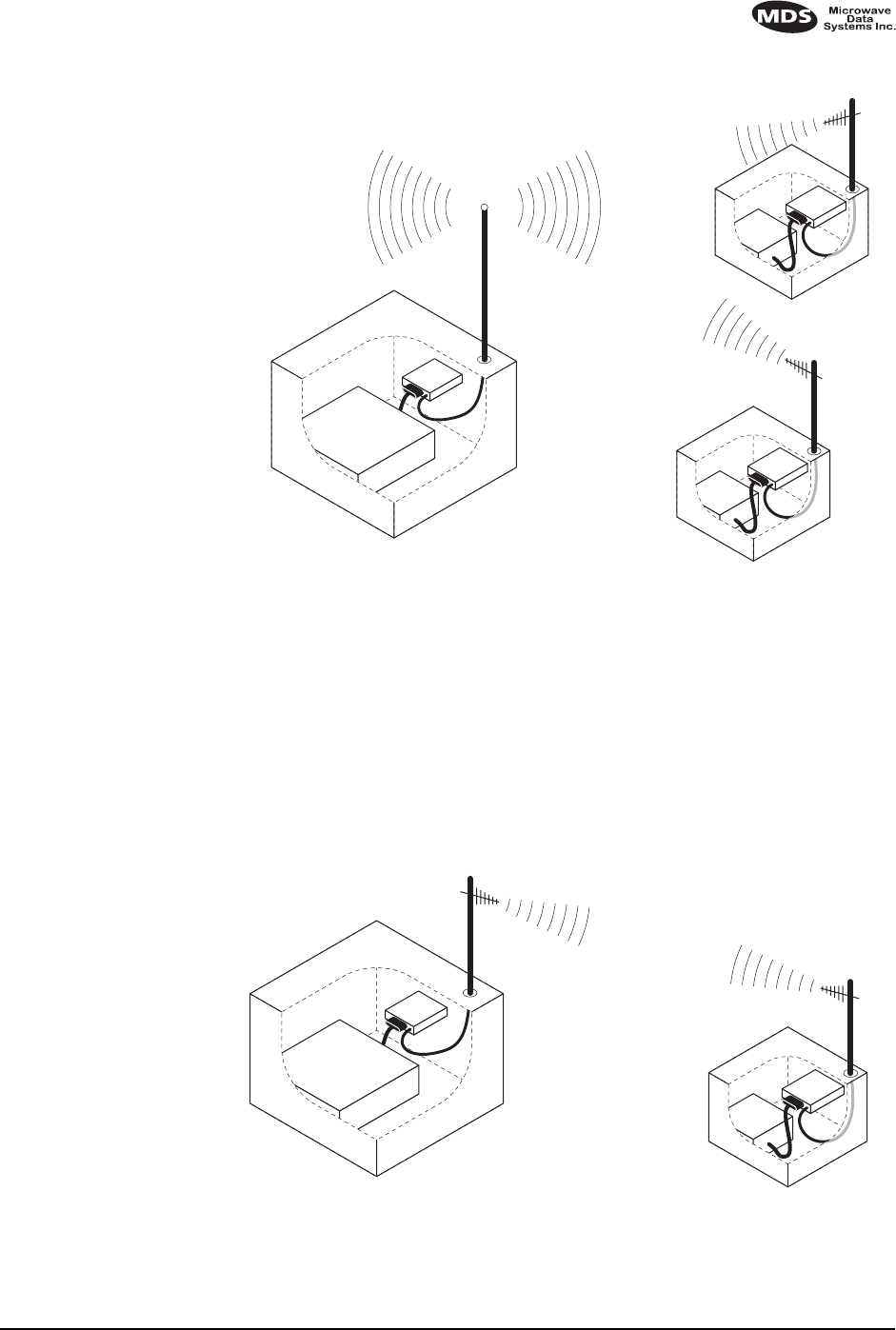
MDS 05-3624A01, Rev. B OEM Series™ I/O Guide 3
Invisible place holder
Figure 2. MAS Point-to-Multipoint Network
(Two remote stations shown—four or more are typically used)
Point-to-Point System
Where permitted, the transceiver may also be used in a point-to-point
arrangement.
A point-to-point system consists of just two radios—one
serving as a master and the other as a remote—as shown in Figure 3. It
provides a simplex or half-duplex communications link for the transfer
of data between two locations.
Invisible place holder
Figure 3. Typical Point-to-Point Link
radio
HOST
COMPUTER
MASTER
STATION
RTU
radio
REMOTE
RTU
radio
REMOTE
radio
HOST
COMPUTER
MASTER
STATION
RTU
radio
REMOTE
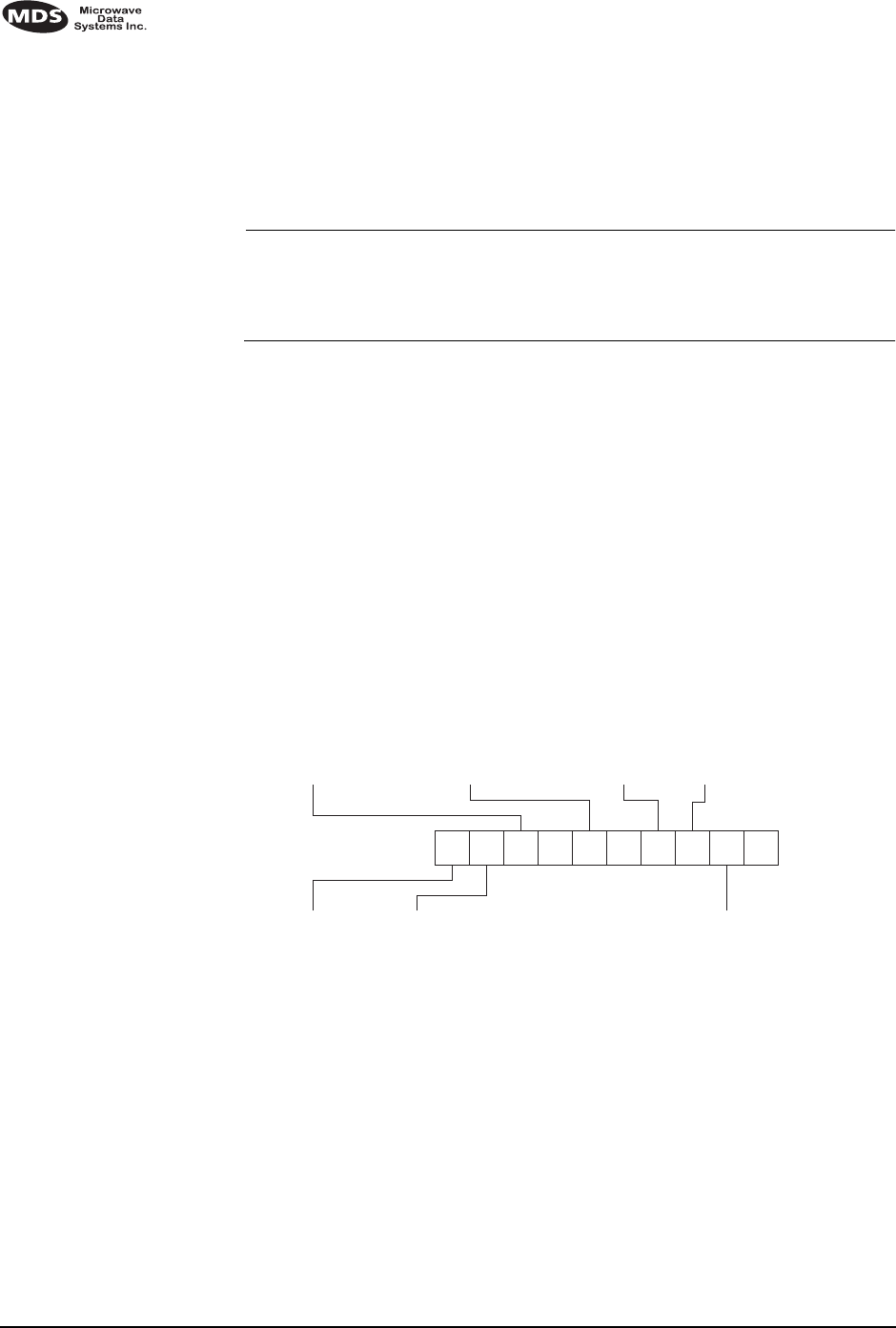
4 OEM Series™ I/O Guide MDS 05-3624A01, Rev. B
Switched Carrier Operation
Switched Carrier operation is a half-duplex mode where the master
station transmitter is keyed to send data and unkeyed to receive. MDS
OEM Series™ radios operate in switched carrier mode and are keyed
when data is present.
NOTE:
MDS OEM Series™ radios do not support full-duplex
operation (i.e., transmitting and receiving at the same time).
For information on other MDS products that provide this
capability, contact your sales representative.
Single Frequency (Simplex) Operation
Single frequency operation (also known as simplex) is a special case of
switched carrier operation. Single frequency operation is
automatically
selected whenever the transmit and receive frequencies are set to the
same value.
1.3 Model Number Codes
The radio model number is printed on the PC board or on the radio
enclosure, and provides key information about how the radio was
configured when was shipped from the factory. See Figure 4 for an
explanation of the model number characters.
Invisible place holder
Figure 4. MDS OEM Series™ Model Number Codes
THIS INFORMATION IS
SUBJECT TO
CHANGE.
DO NOT USE FOR
PRODUCT ORDERING.
EL705
BAND SUB-BAND
9 = 900 MHz A = 928–960 MHz
BANDWIDTH
1 = 12.5 kHz Domestic
ENCLOSURE
0 = Without Enclosure
1 = With Enclosure
SAFETY
N = None
E = Class 1, Div. 2 ENTLA
MODEM
2 = 4800 BPS
3 = 9600 BPS
AGENCY
F = FCC/IC
N = None
NA N

MDS 05-3624A01, Rev. B OEM Series™ I/O Guide 5
1.4 Accessories
The transceiver can be used with one or more of the accessories listed in
Table 1. Contact the factory for ordering information.
Table 1. Optional Accessories
Accessory Description MDS P/N
Hand-Held Terminal
Kit (HHT) Keypad terminal for programming,
diagnostics, and control. Includes
carrying case, cable set and an
instruction booklet. (Accessory Power
Adapter 03-3722A01 required for use
with OEM radios—see below).
02-1501A01
Accessory Power
Adapter DB-25 male-to-female adapter that
attaches to the radio’s DATA
INTERFACE connector. Provides
regulated 10 Vdc for powering an HHT
or other low power accessory. If not
used, accessories could be damaged
by excessive voltage (equal to the
radio’s DC input voltage).
03-3722A01
RTU Simulator Assy. Test unit that simulates data from a
remote terminal unit. Comes with
polling software that runs on a PC.
Used for testing OEM radio operation.
(NOTE: Older MDS RTU Simulators
will
not
work with the OEM radio as
they require a higher input voltage.)
03-2094A01
DB-9 to DB-25 adapter Used to connect a PC with a 9-pin
serial port to the radio’s DATA
INTERFACE port.
01-3683A01
Radio Configuration
Software (EL705) Radio programming software for use
with a Windows-based PC. This
program is available on 3.5” disks, and
is included on the MDS’ InSite 6.4 (or
higher) CD.
03-3649A01
PC Programming
Adapter Kit Required when programming the radio
with a personal computer operating in
terminal mode. The adapter asserts
the auto-open signal (ground) on pin
23 of the DATA INTERFACE port. A
scratch-built cable may also be used
for this purpose (see Figure 12 on
Page 16).
01-3683A01
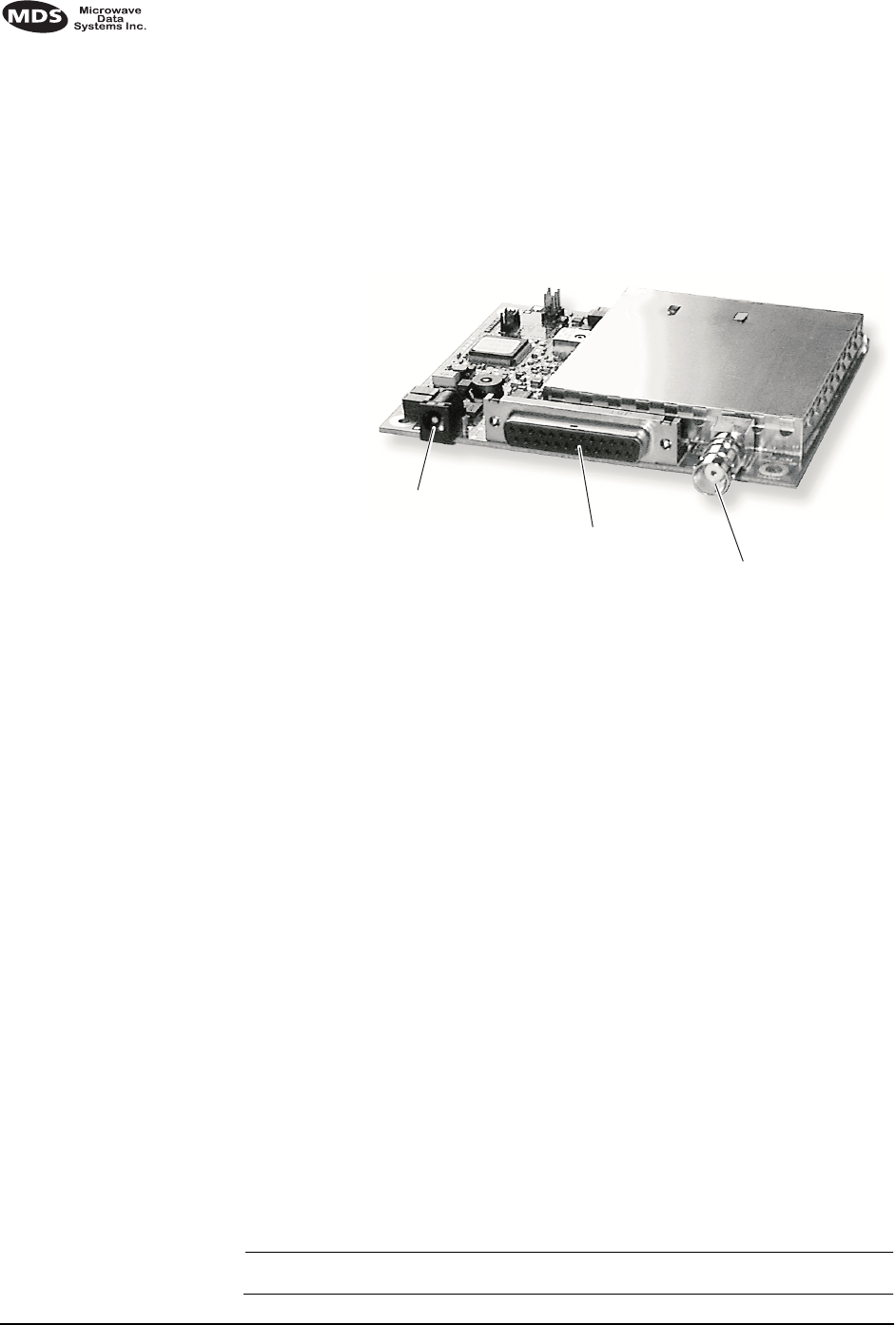
6 OEM Series™ I/O Guide MDS 05-3624A01, Rev. B
2.0 INSTALLATION
There are three main requirements for installing the transceiver—
adequate and stable primary power, a good antenna system, and the
correct data connections between the transceiver and the data device.
Figure 5 shows the external connections for the transceiver.
Invisible place holder
Figure 5. External Connections to the Transceiver Board
(Connector locations identical to enclosed radio)
2.1 Installation Steps
Below are the basic steps for installing the transceiver. In many cases,
these steps alone are sufficient to complete the installation. More
detailed explanations appear at the end of these steps.
1. Mount the transceiver to a stable surface using the appropriate
hardware.
2. Install the antenna and antenna feedline for the station. Preset
directional antennas in the desired direction of transmission and
reception.
3. Measure and install the primary power for the radio. The primary
power must be between 10 and 16 Vdc and be capable of supplying
at least 2 Amperes. (This requirement assumes a 5 watt RF output.
Lower current consumption is possible if lower output power can be
used in your application—see OEM Series™ Transceiver
Specifications on Page 26 for details.)
NOTE: Use the radio in negative ground systems only.
ANTENNA
CONNECTOR
(BNC)
DATA INTERFACE
CONNECTOR
(DB-25)
Final model will have a polarized
2-pin power connector (plug & cable
assembly included). Red wire is
positive(+); black is negative (-).
POWER CONNECTOR*
(TIP/RING BARREL TYPE)
*

MDS 05-3624A01, Rev. B OEM Series™ I/O Guide 7
4. Set the radio configuration. The transceiver is designed for quick
installation with a minimum of software configuration in most cases.
The selections that need to be verified for new installations are:
•Transmit frequency
•Receive frequency
•Transmitter output power
•Network address (factory default is NONE)
The operating frequencies are not set at the factory unless they are
specified at the time of order. Determine the transmit and receive
frequencies to be used, and follow the steps below to program them.
5. Connect a terminal interface (personal computer or a hand-held
terminal) to the DATA INTERFACE connector. (See PC Connection
and Startup on Page 14 for details.)
6. Press to receive the ready “>” prompt.
a. Set the transmit frequency with the TX xxx.xxx command.
Press after the command.
b. Set the receive frequency with the RX xxx.xxx command.
Press after the command.
c. Set the network address with the ADDR xxx command.
Press after the command. After programming, the
terminal interface reads PROGRAMMED OK to indicate successful
entry.
7. Disconnect the terminal interface from the DATA INTERFACE
connector.
8. Connect the data equipment to the transceiver’s DATA INTERFACE
connector. Use only the required pins for the application—do not
use a fully pinned (25 conductor) cable. Basic applications often
require only the use of Pin 2 (Transmitted Data—TXD), Pin 3
(Received Data—RXD), and Pin 7 (Signal Ground).
Additional connections may be required in some installations. Refer
to the complete list of pin functions in Table 3 on Page 11.
ENTER
ENTER
ENTER
ENTER
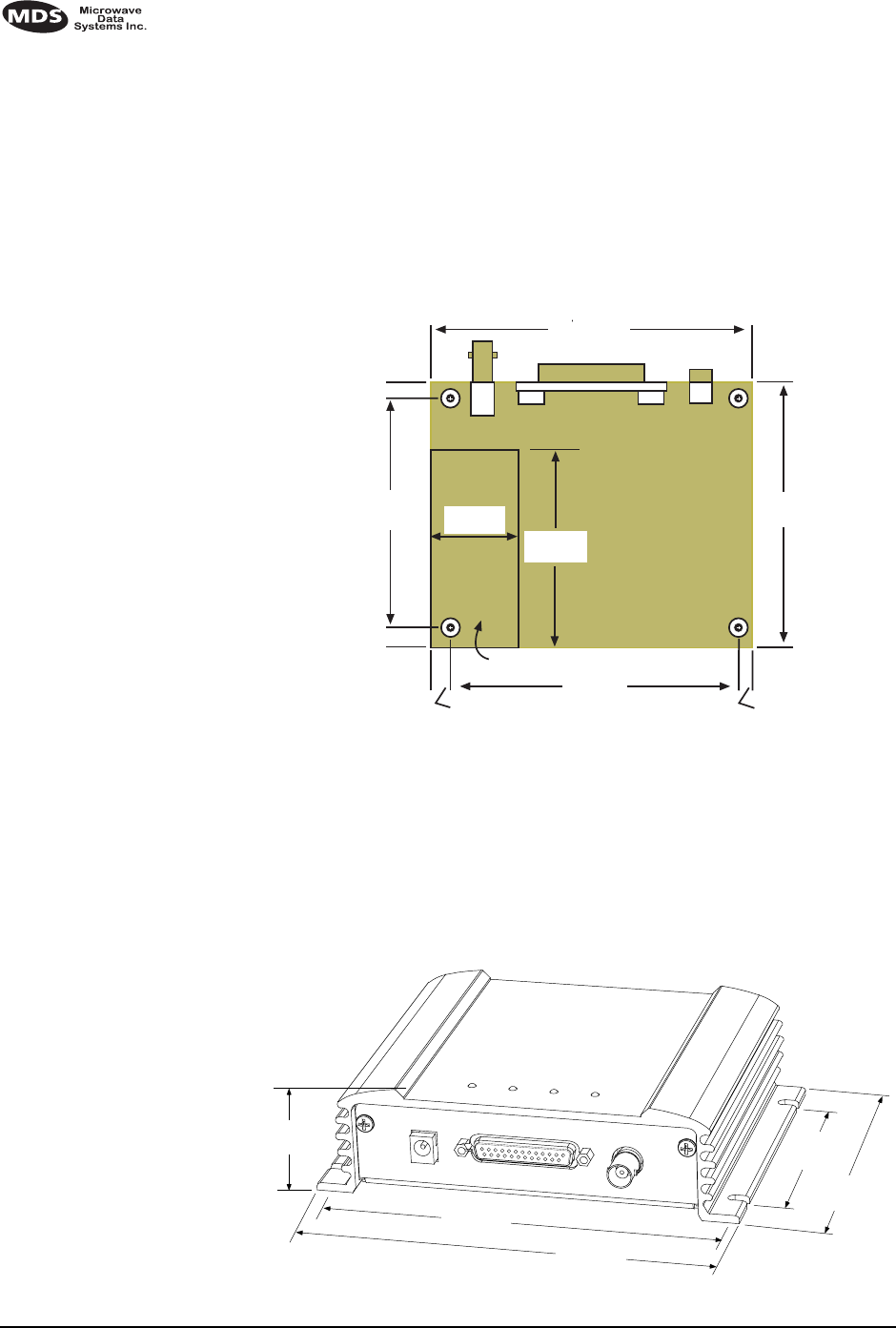
8 OEM Series™ I/O Guide MDS 05-3624A01, Rev. B
2.2 Mounting the Transceiver
Transceiver Board
Figure 6 shows the mounting dimensions of the transceiver PC board.
The board should be secured to the mounting surface using the holes
provided at each corner of the assembly. (Fasteners are not supplied.)
Note that the lower left mounting hole in the board is a threaded ferrule.
Invisible place holder
Figure 6. Transceiver Mounting Dimensions (Board Version)
Enclosed Transceiver
Figure 7 shows the mounting dimensions of the enclosed transceiver.
Two cutout slots are provided on each side of the enclosure for
mounting screws. (Fasteners are not supplied.)
Invisible place holder
Figure 7. Transceiver Mounting Dimensions (Enclosed Version)
RF DATA PWR
4.53 in.
(11.51 cm)
0.23 in.
(0.58 cm)
3.23 in.
(8.20 cm)
0.28 in.
(0.71 cm)
3.73 in.
(9.47 cm)
0.28 in.
(0.71 cm) 0.20 in.
(0.51 cm)
4.05 in.
(10.29 cm)
HEATSINK
2.5 in.
(6.35 cm)
1” in.
(2.54 cm)
HEATSINK HEIGHT: 0.38” (0.97 cm)
3.25 in.
(8.25 cm)
5.00 in.
(12.70 cm)
1.75 in.
(4.45 cm)
5.97 in.
(15.14 cm)
6.50 in.
(16.51 cm)
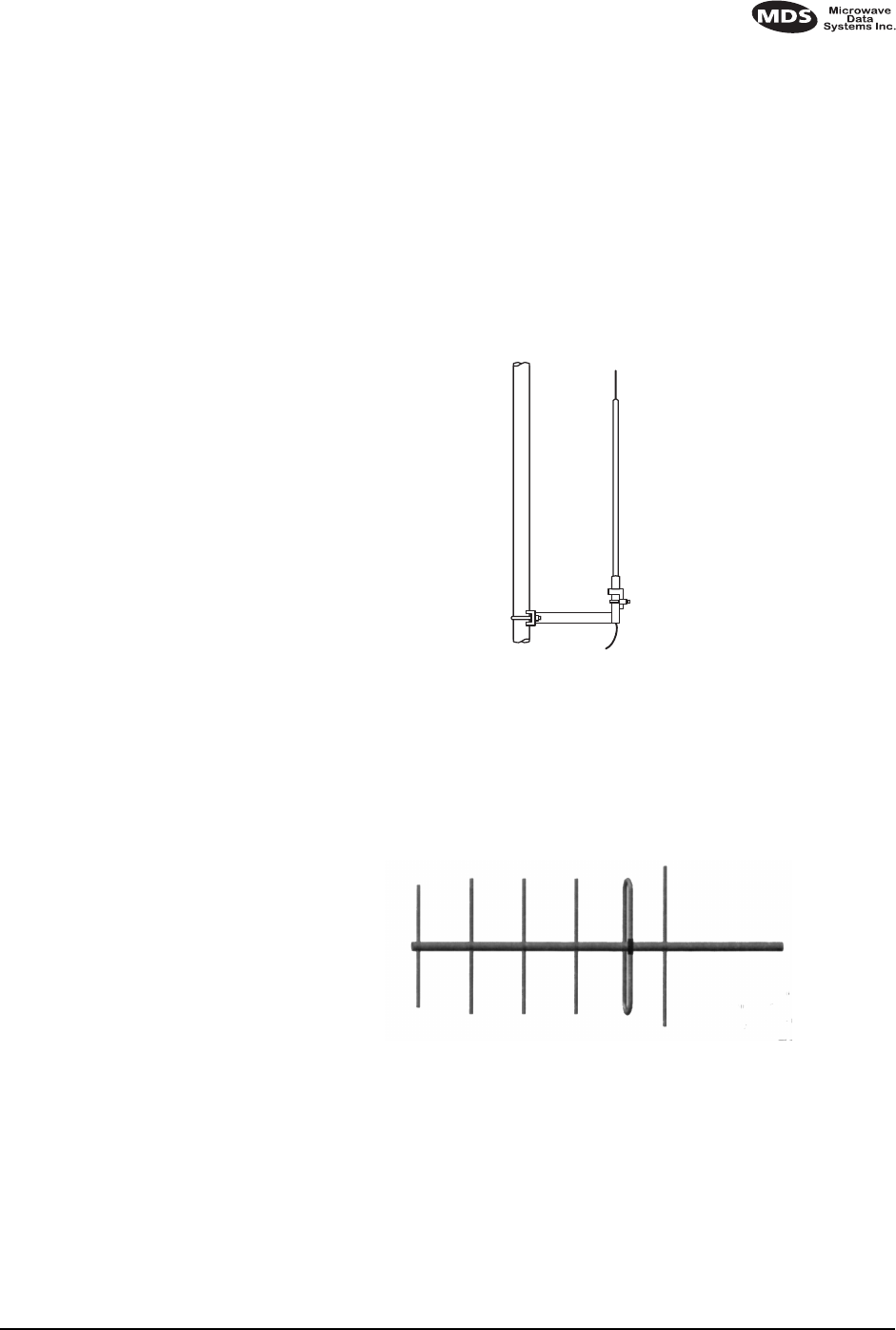
MDS 05-3624A01, Rev. B OEM Series™ I/O Guide 9
2.3 Antennas and Feedlines
Antennas
The transceiver can be used with a number of antennas. The exact style
depends on the physical size and layout of the radio system. Suitable
antennas are available from several manufacturers, including MDS.
At master stations, omni-directional antennas (Figure 8) are typically
used to provide equal coverage to all remote sites in the network.
Invisible place holder
Figure 8. Typical Omni-directional Antenna for Master Stations
(Shown mounted to mast)
At remote sites, a directional Yagi (Figure 9) or corner reflector antenna
is generally recommended to minimize interference to and from other
users.
Invisible place holder
Figure 9. Typical Yagi Antenna for Remote Sites
Feedlines
The selection of antenna feedline is very important. Poor quality cables
should be avoided as they result in power losses that may reduce the
range and reliability of the radio system.
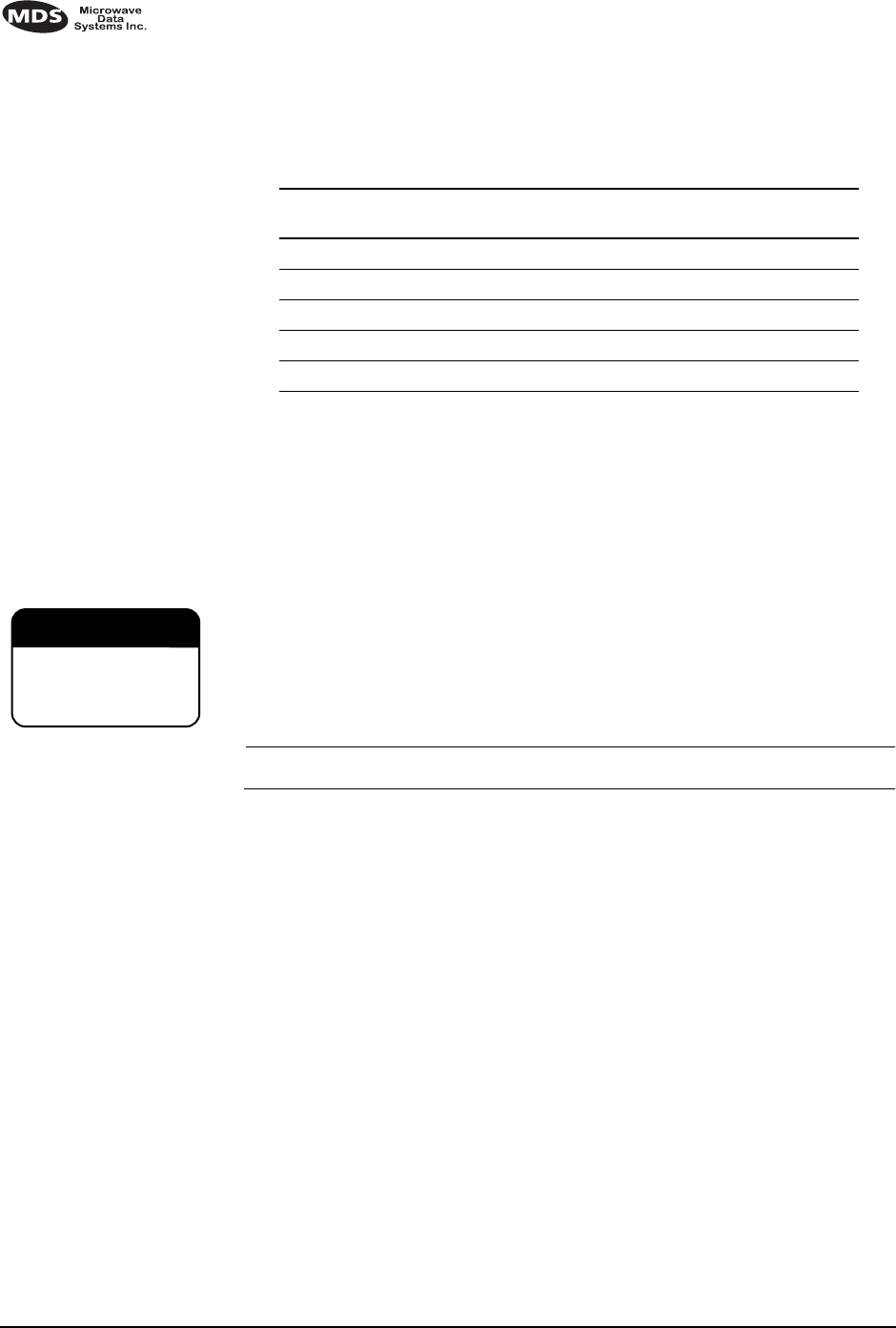
10 OEM Series™ I/O Guide MDS 05-3624A01, Rev. B
Table 2 shows the losses that occur when using various lengths and
types of cable in the 900 MHz band. Regardless of the type of cable
used, it should be kept as short as possible to minimize signal loss.
2.4 Power Connection
The transceiver can be operated from any well-filtered 10 to 16 Vdc
power source. The power supply must be capable of providing at least 2
Amperes if 5 watt output is planned from the transceiver. Supply the
power to the power connector (see Figure 5 on Page 6).
Do not apply power to the radio through Pin 18 of the DB-25
Interface connector. This pin does not provide over-current input
protection, and is intended only as an auxiliary output for powering
a low-current (1.0 Amp max.) device, such as an RTU.
NOTE: The radio is designed for use in negative ground systems only.
Conservation (Sleep Mode)
In some installations, such as at solar-powered sites, it may be necessary
to keep the transceiver’s power consumption to an absolute minimum.
This can be accomplished by configuring the data device (RTU, PLC,
etc.) to ground Pin 12 of the DATA INTERFACE connector, which removes
power from the radio. When the ground is removed, the radio is ready
to operate within 75 milliseconds.
2.5 Data Interface Connections
The transceiver’s DATA INTERFACE connector is configured as a DCE
(modem) and is normally connected to an EIA-232 device. The
transceiver supports over-the-air asynchronous data rates up to
19200 bps. Refer to Figure 10 and Table 3 for a detailed description of
each pin on the DATA INTERFACE connector.
Table 2. Length vs. Loss in Coaxial Cables at 900 MHz
Cable Type 3 Meters
(10 Feet) 15 Meters
(50 Feet) 30 Meters
(100 Feet) 150 Meters
(500 Feet)
RG-8A/U 0.85 dB 4.27 dB 8.54 dB 42.70 dB
1/2 inch HELIAX 0.23 dB 1.15 dB 2.29 dB 11.45 dB
7/8 inch HELIAX 0.13 dB 0.64 dB 1.28 dB 6.40 dB
1-1/4 inch HELIAX 0.10 dB 0.48 dB 0.95 dB 4.75 dB
1-5/8 inch HELIAX 0.08 dB 0.40 dB 0.80 dB 4.00 dB
CAUTION
POSSIBLE
EQUIPMENT
DAMAGE
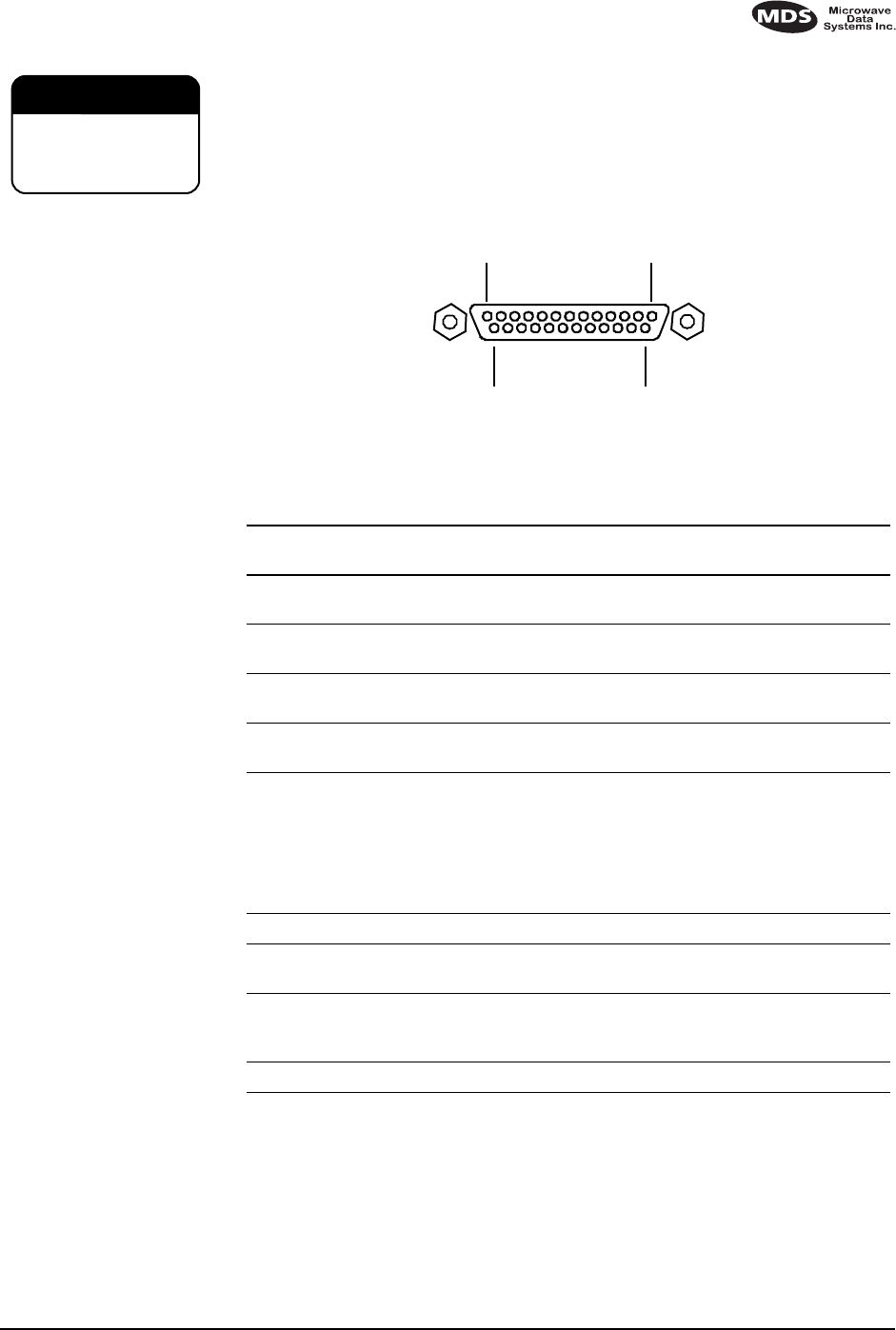
MDS 05-3624A01, Rev. B OEM Series™ I/O Guide 11
Do not use a 25 wire (fully pinned) cable for connection to the DATA
INTERFACE connector. Use only the required pins for the application.
Damage may result if improper connections are made. For EIA-232
signaling, typical applications require the use of Pins 2, 3, and 7
only.
Invisible place holder
Figure 10. Data Interface Connector Pinouts
(As viewed from the front of the radio)
CAUTION
USE
ONLY REQUIRED
PINS
1
13
25 14
Table 3. DATA INTERFACE Connector Pinouts
Pin
Number Input/
Output Pin Description
1--Protective Ground. Connects to ground (negative supply
potential) on the radio’s PC board and chassis.
2INTXD—Transmitted Data. Accepts TX data from the
connected device.
3 OUT RXD—Received Data. Outputs received data to the
connected device.
4INRTS—Request-to-Send Input. Causes CTS to go
“high.”
5 OUT CTS—Clear-to-Send Output. Behavior depends on
DEVICE command setting:
When DEVICE is set to DCE, this pin follows RTS and will
provide “buffer full” flow control.
When DEVICE is set to CTS KEY, this pin provides a
keyline output when receive data is present.
6 OUT DSR—Data Set Ready. Active when radio is powered on.
7--Signal Ground. Connects to ground (negative supply
potential) at radio’s PC board.
8 OUT DCD—Data Carrier Detect. Active when receiving
data from another OEM Series radio with the same
network address.
11 OUT Receive Audio Output. For test purposes only.

12 OEM Series™ I/O Guide MDS 05-3624A01, Rev. B
12 -- Sleep Mode. A logic low on this pin removes power from
the radio. The radio is ready to operate 75 milliseconds
after the ground is removed.
18 IN/OUT Accessory Power. Unregulated Output. Provides a
source of output power for low current (1 Amp max.)
accessories. Excessive drain on this connection causes
the on board fuse (2 ampere) to open. The voltage at this
pin matches the input voltage to the transceiver. Do not
use this pin for powering the radio.
19 OUT 5.8 Vdc Regulated Output. Provides a source of
regulated voltage at 100 mA for low power accessories.
23 IN Auto-Open. A logic low (less than 0.5 volts or ground)
on this pin opens the diagnostic channel and disables
normal data operation. A logic high (greater than 4 volts or
open) enables the DATA INTERFACE for normal data
operation.
25 OUT Alarm. A logic low (less than 0.5 volts) on this pin indicates
normal operation. A logic high (greater than 4 volts)
indicates that some alarm condition is present. This pin
can be used as an alarm output, provided the internal
series resistance of 1 kΩ is considered.
Table 3. DATA INTERFACE Connector Pinouts (Continued)
Pin
Number Input/
Output Pin Description

MDS 05-3624A01, Rev. B OEM Series™ I/O Guide 13
3.0 OPERATION
In-service operation of the transceiver is completely automatic. Once
the unit has been properly installed and configured, operator actions are
limited to observing the radio’s LED status indicators for proper
operation.
3.1 Initial Startup
If all parameters are set correctly, operation of the radio can be started
with these steps:
1. Apply DC power to the transceiver.
2. Observe the LED status panel for the proper indications (see
Table 4).
3. If not done earlier, refine the antenna heading of the station to
maximize the received signal strength (RSSI) from the master
station. Use the RSSI command from a terminal interface connected
to the radio’s DATA INTERFACE connector.—See Section 4.0,
TRANSCEIVER PROGRAMMING.
3.2 LED Indicators
The transceiver includes four status LEDs visible from the top of the
unit, behind the Data Interface connector (or on the front panel in
enclosed units). Table 4 describes the function of each status LED.
RXDTXDDCDPWR
Table 4. LED Status Indicators
LED Name Description
PWR
(Power) •Continuous—Power is applied to the radio, no problems
detected.
•Rapid flash (five times-per-second)—Fault indication.
•Flashing once every second—Unit is not programmed.
Radio is in Bootloader mode.
DCD
(Data Carrier Detect) Flashing—Indicates another radio (with the same network
address) is transmitting at the radio’s receive frequency.
RXD
(Receive Data) Receive data is present on DATA INTERFACE connector.
TXD
(Transmit Data) Transmit data is present on DATA INTERFACE connector.

14 OEM Series™ I/O Guide MDS 05-3624A01, Rev. B
4.0 TRANSCEIVER PROGRAMMING
Programming and set-up of the transceiver is performed through the
radio’s DATA INTERFACE connector with a terminal interface—either a
personal computer or a hand-held terminal (HHT). This section contains
a reference chart of commands (Table 5) followed by detailed
descriptions for each entry.
4.1 Radio Programming Methods
➊ PC with Radio Configuration Software
PC-based Radio Configuration software is available for use with the
radio (MDS P/N 03-3649A01). This software is normally supplied on
3.5” disks, but can also be found on the MDS InSite disk (version 6.4 or
higher) under the title of “EL705.” On-line instructions are included
with the configuration software.
NOTE: When using radio configuration software, click on the opening
screen or press a key to activate the program.
➋ PC in Terminal Mode
A PC may also be used without the Radio Configuration software by
operating it in a basic terminal mode (e.g., HyperTerminal session) and
entering the radio commands listed in Table 5. The terminal
communication parameters must be set to 9600 bps, with 8 data
bits, no parity, and 1 stop bit (8N1).
➌ Handheld Terminal (HHT)
A Hand-Held Terminal kit (MDS P/N 02-1501A01) may be used to
enter the radio commands listed in Table 5. The HHT communication
parameters must be set to 9600 bps, with 8 data bits, no parity, and
1 stop bit (8N1).
4.2 PC Connection and Startup
Follow the steps below to prepare the radio for PC programming. For
information about connecting and setting up a hand-held terminal, refer
to the instructions provided with each HHT kit.:
1. Connect a PC to the radio’s DATA INTERFACE port as shown in
Figure 11. Pin 23 of the interface cable must be grounded to activate
the control and programming mode. This can be done with a
Programming Adapter (MDS P/N 01-3683A01), or with a
scratch-built cable as shown in Figure 12.
2. Press to obtain the ready “>” prompt.
ENTER
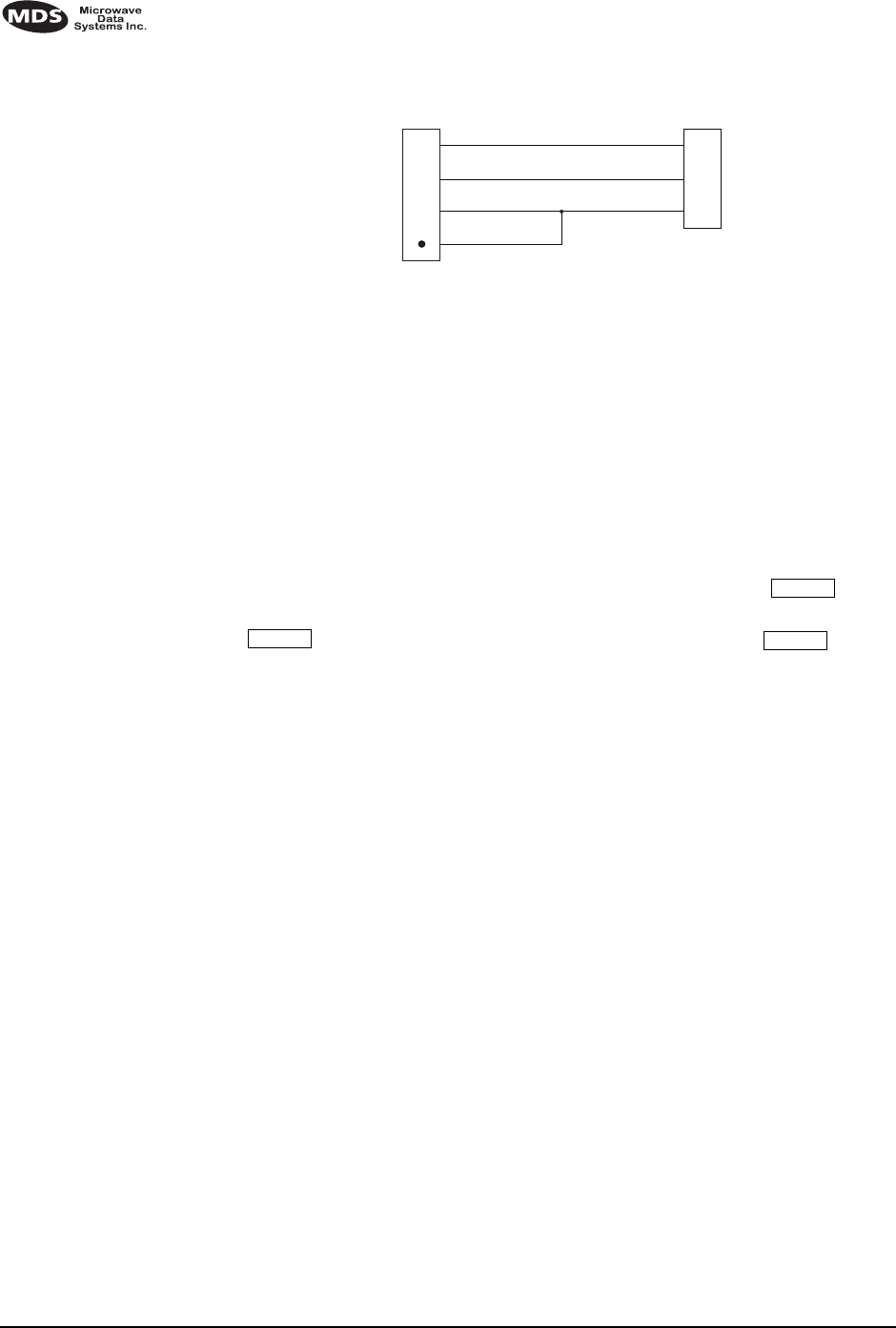
16 OEM Series™ I/O Guide MDS 05-3624A01, Rev. B
Invisible place holder
Figure 12. DB-25 to DB-9 Adapter Cable
(For PC control and programming)
4.3 Keyboard Commands
Table 5 is a reference chart of software commands for the transceiver.
Programmable information is shown in brackets [ ] following the
command name. See section 4.4 following the table for detailed
command descriptions.
Entering Commands
To enter a command, type the command, followed by an
keystroke. For programming commands, the command is followed by
and the appropriate information or values, then .
Error Messages
Listed below are some possible error messages that may be encountered
when using the terminal interface:
UNKNOWN COMMAND—The command was not recognized. Refer to the
command description for command usage information.
INCORRECT ENTRY—The command format or its associated values were
not valid. Refer to the command description for command usage
information.
COMMAND FAILED—The command was unable to successfully complete.
This may indicate an internal software problem.
NOT PROGRAMMED—Software was unable to program the internal radio
memory or the requested item was not programmed.This is a serious
internal radio error. Contact MDS for assistance.
TEXT TOO LONG—Response to OWN or OWM command when too many
characters have been entered. Refer to the command description for
command usage information.
NOT AVAILABLE—The entered command or parameter was valid, but it
referred to a currently unavailable choice. Refer to the command
description for command usage information.
RXD
TXD
GND
2
3
5
DB-9 FEMALE
(TO COMPUTER)
TXD
RXD
GND
2
3
7
DB-25 MALE
(TO RADIO)
Diagnostics Open
23
ENTER
SPACE ENTER
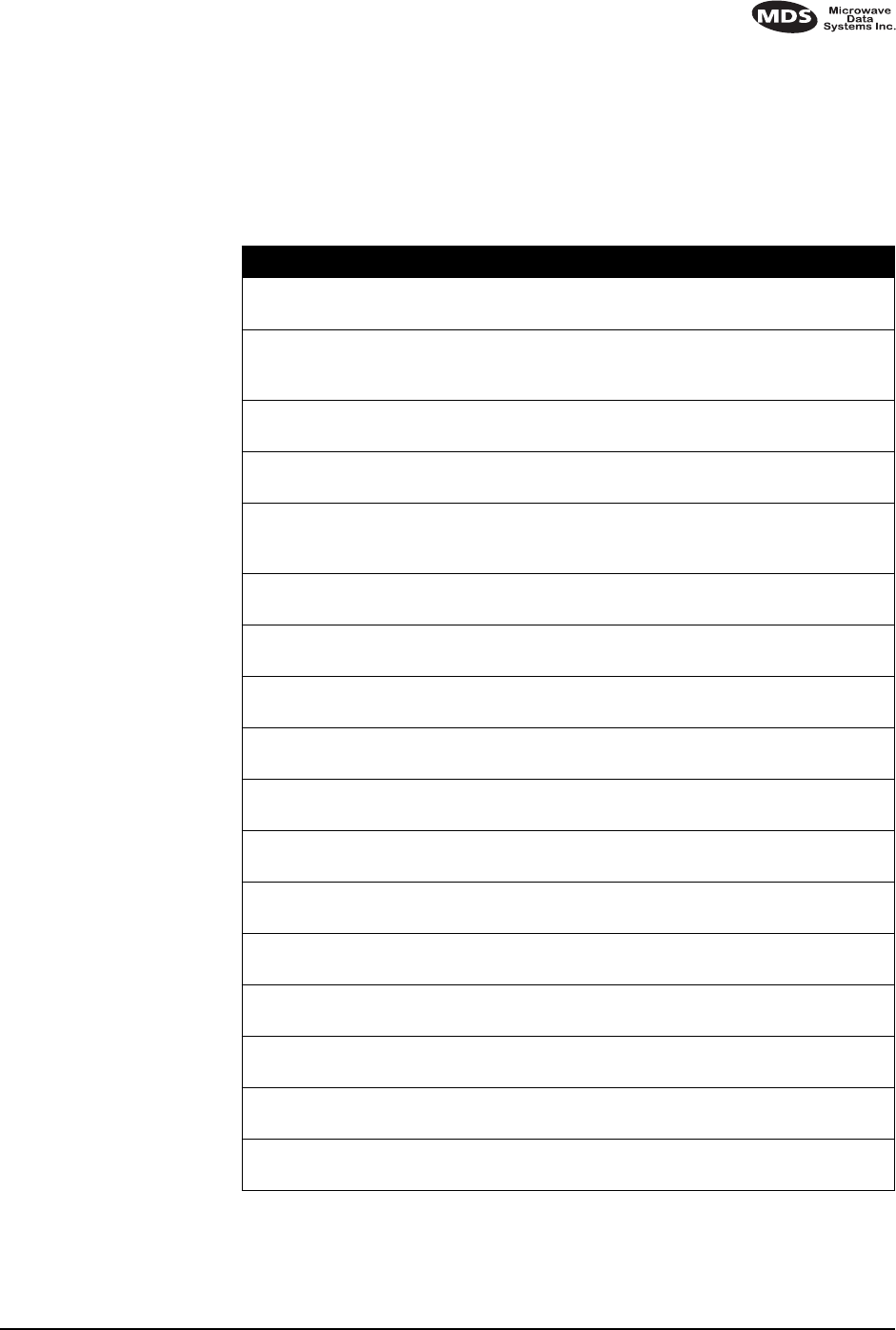
MDS 05-3624A01, Rev. B OEM Series™ I/O Guide 17
ACCESS DENIED—The command is unavailable to the user. Refer to the
command descriptions for command information.
EEPROM FAILURE— The INIT command was unable to write to EEPROM.
This usually indicates a hardware error. Contact MDS for assistance.
Table 5. Command summary
Command name Function
ADDR [NONE | 1–255]
Details page 18 Set or display the network address of the radio.
AMASK [0000
0000–FFFF FFFF]
Details page 18
Set or display hex code identifying which events
trigger an alarm.
BAUD [xxxxx abc]
Details page 19 Set or display the DATA INTERFACE data rate
and format.
CTS [0–255]
Details page 19 Set or display the Clear-to-Send delay in
milliseconds.
CTSHOLD [0–60000]
Details page 19 Set or display the delay, in milliseconds, at the
end of a CTS line response; CTS Key operation
only.
DEVICE [DCE | CTS KEY]
Details page 20 Set or display the CTS options.
DKEY
Details page 20 Dekey the radio (transmitter OFF) following a
KEY command.
INIT
Details page 20 Set radio parameters to factory defaults.
KEY
Details page 21 Key the radio (transmitter ON). Provides a carrier
for testing.
OWM [XXX...]
Details page 21 Set or display the owner’s message.
OWN [XXX...]
Details page 21 Set or display the owner’s name.
PWR [L | M | H]
Details page 21 Set or display the transmit power setting.
RSSI and RSSI!
Details page 22 Display the Received Signal Strength Indication.
RX [xxx.xxx]
Details page 22 Set or display the receive frequency.
RXTOT [NONE | 1–255]
Details page 22 Set or display the value of the receive time-out
timer.
SER
Details page 22 Display the radio serial number.
SREV
Details page 22 Display the software revision level.

18 OEM Series™ I/O Guide MDS 05-3624A01, Rev. B
4.4 Detailed Command Descriptions
The only essential commands for most applications are transmit
frequency (TX xxx.xxx), receive frequency (RX xxx.xxx), and network
address (ADDR xxx). However, proper use of the additional commands
allows you to tailor the transceiver for a specific use or conduct basic
diagnostics on the radio. This section gives more detailed information
for the user commands previously listed in Table 5.
In many cases, the commands shown here can be used in two ways.
First, you can type only the command name to view the currently
programmed data. Secondly, you can set or change the existing data by
typing the command, followed by a space, and then the desired entry. In
the list below, allowable data values, if any, are shown in brackets
following the command name. The separator symbol (|) indicates that
you can enter one of the values in the list.
ADDR [NONE | 1–255]
The ADDR command displays or sets the network address of the radio. In
order for all the radios in a network to communicate, their network
addresses must be identical, or set to NONE. (The radio is shipped from
the factory with ADDR set to NONE.)
AMASK [0000 0000–FFFF FFFF]
The AMASK (alarm mask) command displays or sets which events cause
the alarm output signal to be active. Normally, the mask is FFFF FFFF,
meaning that any of the 32 possible events activate the alarm output
signal. No special configuration is required for typical applications.
Entering the AMASK command alone displays the current setting of
alarm events in hexadecimal format.
Entering the AMASK command followed by an eight-digit hexadecimal
number reprograms the specified events to trigger an alarm.
Each bit that is a ‘1’ identifies an associated alarm condition that can
trigger the alarm output status line. Each bit that is a ‘0’ treats the
associated alarm as irrelevant when deciding whether or not to assert the
alarm output status line.
STAT
Details page 22 Display the current alarm status.
TOT [1–255 | ON | OFF]
Details page 23 Set or display the time-out timer status and the
timer delay in milliseconds.
TX [xxx.xxx]
Details page 23 Set or display the transmit frequency.
Table 5. Command summary (Continued)
Command name Function

MDS 05-3624A01, Rev. B OEM Series™ I/O Guide 19
Thus, an eight-digit hexadecimal number can classify up to 32 events as
alarm triggers for the alarm output status line. See Table 6 on Page 25
for a list of the event codes and their hex values. The hex value of the
mask is simply the sum of the hex values of the event codes
corresponding to the alarm triggering events.
BAUD [xxxxx abc]
This command sets (or displays) the communication attributes for the
DATA INTERFACE port.
The first parameter (xxxxx) is baud rate. Baud rate is specified in
bits-per-second (bps) and must be one of the following speeds: 1200,
2400, 4800, 9600, or 19200.
The second parameter of the BAUD command (abc) is a three-character
block indicating how the data is formatted:
a = Data bits (7 or 8)
b = Parity (N for None, O for Odd, E for Even)
c = Stop bits (1 or 2)
The factory default setting is 9600 baud, 8 data bits, no parity, 1 start bit,
and 1 stop bit (Example: 9600 8N1).
NOTE: 7N1, 8O2, and 8E2 are invalid communication settings and are
not supported by the transceiver.
CTS [0–255]
The CTS (clear-to-send) command sets or displays the timer value
associated with the CTS line response. The command parameter ranges
from 0 to 255 milliseconds.
For DCE operation (see DEVICE command), the timer specifies how long
to wait after the RTS line goes high, before the radio asserts CTS. A CTS
value of zero asserts the CTS line immediately after the RTS line goes
high.
For CTS Key operation (see DEVICE command), the timer specifies how
long to wait after asserting the CTS, before data becomes available. A
timer value of zero means that data is available as soon as received
CTSHOLD [0–60000]
For CTS Key operation (see DEVICE command), the CTSHOLD command
sets or displays the timer value associated with the end of a CTS line
response. The timer value specifies the length of time that CTS remains
active following the last byte from the RXD pin of the DATA INTERFACE
port. The time is in milliseconds. The default value is 0, which means
that CTS drops immediately after the last byte.

20 OEM Series™ I/O Guide MDS 05-3624A01, Rev. B
For DCE operation (see DEVICE command), this command has no effect.
The response CTSHOLD n/a is displayed.
DEVICE [DCE | CTS KEY]
The DEVICE command sets or displays the device behavior of the radio.
The command parameter is either DCE or CTS KEY.
The default selection is DCE. In this mode, CTS goes high following
RTS, subject to the CTS programmable delay time. Hardware flow
control is implemented by signaling the CTS line if data arrives faster
than it can be buffered and transmitted. The transceiver does not require
an RTS/CTS handshake. Data is transmitted whenever there is data to
send.
If CTS KEY is selected, the CTS line transforms to a Receive Data
indicator (with programmable delays) in order to provide a control line
for use by other devices. The RTS line is ignored. CTS is asserted
immediately following the receipt of RF data, but data is not sent out the
DATA INTERFACE port until the CTS programmable delay time has
expired. (See CTSHOLD description for the delay available following the
data.)
A typical use of CTSKEY is to provide a keyline (or RTS signal) for a
half-duplex modem or other radio.
DKEY
This command deactivates the transmitter after it has been keyed with
the KEY command.
NOTE: The DKEY and KEY commands are not intended for normal
operation. They are tools for field testing and installation.
INIT
The INIT command is used to re-initialize the radio’s operating
parameters to the factory defaults. This may be helpful when trying to
resolve configuration problems that may have resulted from the entry of
one or more improper command settings. Entry of this command allows
you to get back to a known working state. The following changes to the
radio are made when INIT is entered:
•AMASK is set to FFFF FFFF
•BAUD is set to 9600 baud, 8 data bits, no parity, and 1 stop bit
(9600 8N1)
•CTS is set to 0
•CTSHOLD is set to 0
•DEVICE is set to DCE

MDS 05-3624A01, Rev. B OEM Series™ I/O Guide 21
•PWR is set to H [+37 dBm (5 watts)]
•RXTOT is set to NONE
•TOT is set to OFF
All other commands stay at their previously established settings.
KEY
This command activates the transmitter. The transmitter stays keyed
until either the DKEY command is entered, or the transmitter time-out
timer is enabled and times out. See also the DKEY and TOT commands.
NOTE: The KEY and DKEY commands are not intended for normal
operation. They are tools for field testing and installation.
OWM [XXX...]
This is a command to display or set an owner’s message. To program
the owner’s message, type OWM then the message, followed by .
The maximum number of characters that can be entered is 30.
To display the owner’s message, type OWM then . The owner’s
message appears on the display.
OWN [XXX...]
This is a command to display or set an owner’s name. To program the
owner’s name, type OWN then the name, followed by . The
maximum number of characters that can be entered is 30.
To display the owner’s name, type OWN then . The owner’s
name appears on the display.
PWR [L | M | H]
NOTE: This function may not be available, depending on certification
requirements for a particular region.
This command displays or sets the desired RF forward output power
setting of the radio. The PWR command parameter is specified as
L (low), M (medium), or H (high). The default setting is H. The values of
L, M, and H are:
L = 24 dBm (250 mW)
M = 30 dBm (1 W)
H = 37 dBm (5 W)
ENTER
ENTER
ENTER
ENTER

22 OEM Series™ I/O Guide MDS 05-3624A01, Rev. B
RSSI and RSSI!
These commands continuously display the radio’s Received Signal
Strength Indication (RSSI) in dBm units. Incoming signal strengths
from –50 dBm to –120 dBm are displayed.
The RSSI command causes display of received signal strength, updated
once every second. Press to terminate the display.
The RSSI! command displays a one-time reading of the RSSI at the
diagnostic port.
RX [xxx.xxx]
This command sets or displays the radio’s receive frequency in MHz.
The frequency must be an integer multiple of the step size and must be
in the valid range. If the entered frequency is invalid, the terminal
interface displays the message INCORRECT ENTRY.
NOTE: The frequency must be in the valid range for the sub-band
purchased, and may not be programmed “between” channels.
RXTOT [NONE | 1–255]
The RXTOT command sets or displays the receive time-out timer value in
minutes. This timer triggers an alarm (event 12) if data is not detected
within the specified time.
Entering the RXTOT command without a parameter displays the timer
value in minutes. Entering the RXTOT command with a parameter
ranging from 1 to 255 resets the timer in minutes. Entering the RXTOT
command with the parameter NONE disables the timer.
SER
This command displays the radio’s serial number as recorded at the
factory.
SREV
This command displays the software revision level of the transceiver
firmware.
STAT
This command displays the current alarm status of the transceiver.
If no alarms exist, the message NO ALARMS PRESENT appears at the top
of the terminal display.
ENTER

MDS 05-3624A01, Rev. B OEM Series™ I/O Guide 23
If an alarm does exist, a two-digit code (00–31) is displayed and the
alarm is identified as MAJOR or MINOR. A brief description of the alarm
code is also given. Detailed descriptions of event codes are provided in
Table 6 on Page 25.
If more than one alarm exists, the word MORE appears at the bottom of
the screen and additional alarms are viewed by pressing the
key. Alarms are displayed in ascending order, major alarms before
minor ones.
TOT [1–255 | ON | OFF]
This command sets or displays the transmitter time-out timer value
(1–255 seconds), as well as the timer status (ON or OFF). The command
parameter can be either the timer value or the status, but not both. The
parameter ON enables the timer; OFF disables the timer.
If the timer is on, and the radio remains keyed for a longer duration than
the TOT value, the transmitter is automatically unkeyed. When this
happens, the radio must be commanded back to an unkeyed state before
a new keying command is accepted.
By default the timer is ON and set to 30 seconds.
TX [xxx.xxx]
This command sets or displays the radio’s transmit frequency in MHz.
The frequency must be an integer multiple of the step size and must be
in the valid range. If the entered frequency is invalid, the terminal
interface displays the message INCORRECT ENTRY.
NOTE: The frequency must be in the valid range for the sub-band
purchased, and may not be programmed “between” channels.
ENTER

24 OEM Series™ I/O Guide MDS 05-3624A01, Rev. B
5.0 TROUBLESHOOTING
Successful troubleshooting of the radio system is not difficult, but it
requires a logical approach. It is best to begin troubleshooting at the
master station, as the rest of the system depends on the master for
polling commands. If the master station has problems, the operation of
the entire network can be compromised.
It is good practice to start by checking the simple things. For proper
operation, all radios in the network must meet these basic requirements:
•Adequate and stable primary power.
•Secure connections (RF, data, and power).
•An efficient and properly aligned antenna system with a good
received signal strength (at least –90 dBm). It is possible for a
system to operate with weaker signals, but reliability may be
degraded.
•Proper programming of the transceiver’s operating parameters
(see Section 4.0, TRANSCEIVER PROGRAMMING).
•The correct interface between the transceiver and the connected
data equipment (correct cable wiring, proper data format, timing,
etc.).
5.1 LED Indicators
The LED status indicators are an important troubleshooting tool and
should be checked whenever a problem is suspected. Table 4 on Page 13
describes the function of each status LED.
5.2 Event Codes
When an alarm condition exists, the transceiver creates a code that can
be read on a terminal connected to the DATA INTERFACE port. These
codes can be very helpful in resolving many system difficulties. Table 6
lists the definitions of the event codes.
Checking for Alarms—STAT command
To check for alarms, enter STAT on the terminal interface. If no alarms
exist, the message NO ALARMS PRESENT appears at the top of the display.
If an alarm does exist, the STAT command displays a two-digit alarm
code (00–31) and the event is identified as a Major or Minor Alarm. A
brief description of the alarm is also given.
If more than one alarm exists, the word MORE appears at the bottom of
the screen. To view additional alarms, press .
ENTER

MDS 05-3624A01, Rev. B OEM Series™ I/O Guide 25
Major Alarms vs. Minor Alarms
Major Alarms—report serious conditions that generally indicate a
hardware failure, or other abnormal conditions that prevent (or seriously
degrade) further operation of the transceiver. Major alarms generally
indicate the need for factory repair. Contact MDS for further assistance.
Minor Alarms—report conditions that, under most circumstances do
not prevent transceiver operation. These include out-of-tolerance
conditions, baud rate mismatches, etc. The cause of these alarms should
be investigated and corrected to prevent possible system failure.
Event Code Definitions
Table 6 contains a listing of the event codes that may be reported by the
transceiver.
Table 6. Event Codes
Event
Code Hex Value Event
Class Description STATUS Message
00 0000 0000 -- No alarms present. No Alarms Present
1–3 -- -- Not used. --
04 0800 0000 Major One or both of the internal programmable
synthesizer loops is reporting an out-of-lock
condition.
Synthesizer
Out-of-Lock
5–7 -- -- Not used. --
08 0080 0000 Major The system is reporting that it has not been
calibrated. Factory calibration is required for proper
radio operation.
Radio Not Calibrated
09 -- -- Not used. --
10 0020 0000 Major The internal microcontroller was unable to properly
program the system to the appropriate EEPROM
defaults. A hardware problem may exist.
EEPROM Write Failure
11 -- -- Not used. --
12 0008 0000 Major Receiver time-out. No data received within the
specified receiver time-out time. Receiver time-out
13 0004 0000 Major Transmitter time-out. The radio was keyed for a
duration exceeding the time-out timer setting. (This
alarm clears the next time the radio keys.)
Transmitter time-out
14–16 -- -- Not used. --
17 0000 4000 Minor A data parity fault has been detected on the DATA
INTERFACE connector. This usually indicates a
parity setting mismatch between the radio and the
RTU.
Data Parity Error
18 0000 2000 Minor A data framing error has been detected on the
DATA INTERFACE connector. This may indicate a
baud rate mismatch between the radio and the
RTU.
Data Framing Error
19–30 -- -- Not used. --

26 OEM Series™ I/O Guide MDS 05-3624A01, Rev. B
6.0 TECHNICAL REFERENCE
6.1 OEM Series™ Transceiver Specifications
MODELS
MDS OEM Series™ 900: Licensed 900 MHz Transceiver
RADIO TYPE
Synthesized, half duplex, 12.5 kHz channel spacing, split frequency, or simplex
ENVIRONMENTAL
Temperature Range: –30 to +60 degrees C
Humidity: 0 to 95% at 40 degrees C
Board Dimensions: 4.53″ W x 0.75″ H x 3.73″ D
11.51 cm W x 1.90 cm H x 9.47 cm D
Enclosed Dimensions: 6.5″ W x 1.75″ H x 5.00″ D
16.51 cm W x 4.45 cm H x 12.70 cm D
Weight: (Board version) 4.5 oz. (0.13 kg)
(Enclosed version) 1 lb. (0.45 kg)
RF Connector: BNC
Enclosure Type (if furnished): Aluminum
TRANSMITTER
Frequency Ranges (900 MHz): 928 to 960 MHz
Frequency Increments: 6.25 kHz (Standard)
5 kHz (Special)
Modulation Type: 4 level CPFSK
Carrier Power: 250 mW, 1 W, 5 W programmable
(+24 DBM, +30 dBM, +37 dBm)
Duty Cycle: 50% (100% with additional heatsinking)
Output Impedance: 50 ohms
Frequency Stability: 1.5 ppm, –30 to +60 degrees C
Channel Spacing: 12.5 kHz
Spurious and Harmonics: –60 dBc
Time-out Timer: 1 to 255 seconds
Transmitter Keying: On data
Key-up Time: 2 ms

MDS 05-3624A01, Rev. B OEM Series™ I/O Guide 27
RECEIVER
Type: Double conversion superheterodyne
(45 MHz and 450 MHz IF)
Frequency Ranges (900 MHz): 928 to 960 MHz
Frequency Increments: 6.25 kHz (Standard)
5 kHz (Special)
Frequency Stability: 1.5 ppm, –30 to +60 degrees C
Spurious and Image Rejection: –70 dB
Sensitivity: 12 dB Sinad @ –116 dBm
Data Performance: 1 x 10-6 @ –108 dBm (9600 bps)
1 x 10-6 @ –111 dBm (4600 bps)
Intermodulation Rejection: –70 dB minimum
Selectivity: 50 dB typical at adjacent channel (EIA)
Bandwidth: 12.5 kHz
DATA INTERFACE
RS-232 through DB-25 Connector
Baud Rates at Interface Port: 1200, 2400, 4800, 9600, and 19200* bps
Over-the-Air Data Rate: 9600 bps
4800 bps
Data Latency: < 20 ms typical
DIAGNOSTICS
Self Test: Yes
Local RS-232 RSSI and Setup: Yes
4 LED Display: PWR, DCD, TXD, and RXD
PRIMARY POWER
Voltage: 10 to 16 Vdc through a 5.5 mm pin plug or 2-pin
MDS connector
RX Current at 13.8 Vdc (typical): 75 mA
TX Current at 13.8 Vdc (typical): 1.75 A @ high power (5W)
700 mA @ medium power (1W)
400 mA @ low power (250 mW)
Circuit Protection: 2 amp fuse, surface mount
Reverse Polarity Protection: Diode across primary input
* At 19200 bps, the radio operates in a buffered mode, storing 50 characters at a time.
6.2 Bench Testing Setup
Figure 13 shows a sample test setup that can be used to verify the basic
operation of transceivers in a shop setting. The test can be performed
with any number of remote radios by using a power divider with the
required number of output connections.
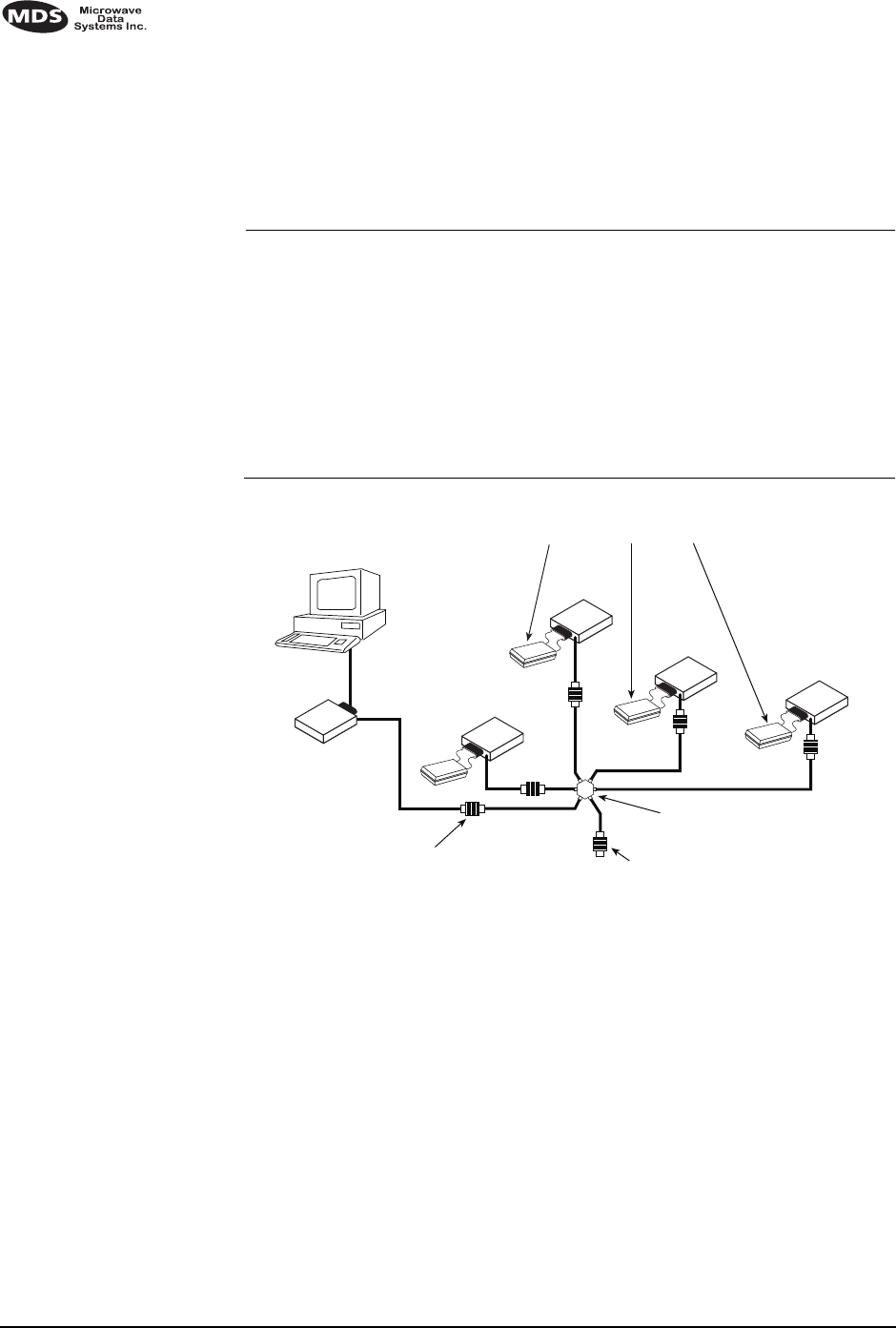
28 OEM Series™ I/O Guide MDS 05-3624A01, Rev. B
The RTU simulator (MDS Part No. 03-2094A01) is a microcontroller
that emulates a remote terminal unit operating at 1200, 2400, 4800, or
9600 bps. Custom software is supplied with the RTU simulator that
allows continuous polling of remote radios using an IBM-compatible
personal computer. The software reports the number of polls sent, polls
received, and the number of errors detected.
NOTE: It is very important to use attenuation between all units in the
test setup. The amount of attenuation required depends on the
number of units being tested and the desired signal strength
(RSSI) at each transceiver during the test.
A maximum level of -50 dBm is recommended at each
transceiver, because the radio’s RSSI reporting will not be
accurate above this level. In no case should a signal stronger
than +10 dBm be applied to any transceiver in the test setup,
or damage may result.
Invisible place holder
Figure 13. Typical setup for bench testing of radios
6.3 Helical Filter Adjustment
If the operating frequency of the radio is changed more than 10 MHz,
the helical filters should be adjusted for maximum received signal
strength (RSSI). If adjustment is required, follow these steps:
1. For enclosed units, remove the top cover from the transceiver by
loosening the eight screws and lifting straight up.
2. Carefully remove the shield cover from the PC board.
3. Locate the helical filters. See Figure 14.
MASTER STATION
COMPUTER RUNNING MDS
POLL.EXE PROGRAM
REMOTE
RADIO
REMOTE
RADIO
REMOTE
RADIO REMOTE
RADIO
NON-RADIATING ATTENUATOR
•Install on any unused divider ports
•2W minimum rating
POWER DIVIDER
POWER ATTENUATORS
•Fixed or adjustable
•2W minimum rating
RTU SIMULATORS
(SEE TEXT)
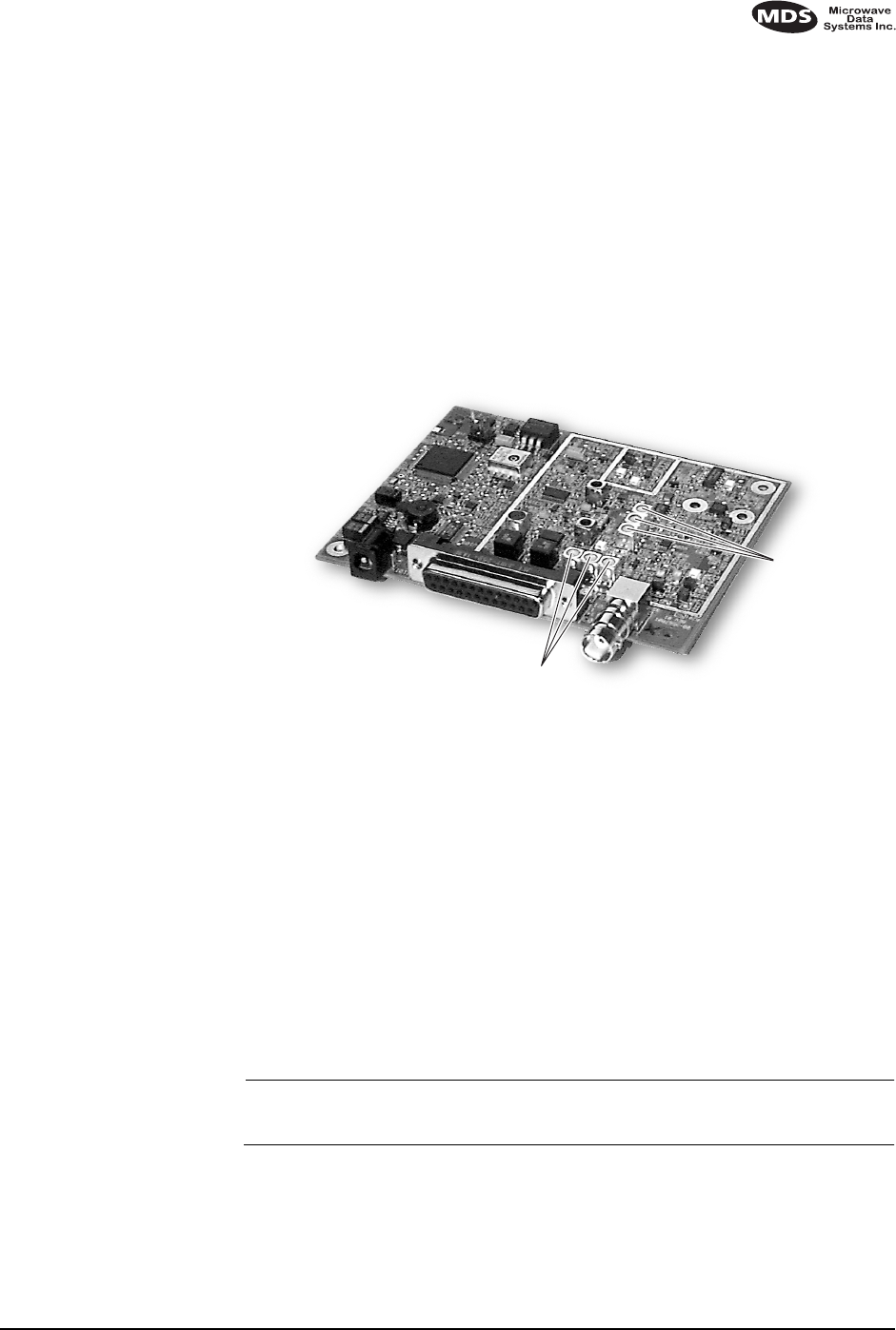
MDS 05-3624A01, Rev. B OEM Series™ I/O Guide 29
4. Apply a steady signal to the radio at the programmed receive
frequency (–80 dBm level recommended; no stronger than –60
dBm). This can be done with a signal generator or an over-the-air
signal.
5. Measure the radio’s RSSI using a terminal interface. See
Section 4.0, TRANSCEIVER PROGRAMMING on Page 14.
6. With a non-metallic tool, carefully adjust each section of the helical
filter for maximum RSSI. Repeat several times to work out any
interactions. Re-install the cover to the transceiver.
Invisible place holder
Figure 14. Helical Filter Location
(Shield cover removed)
6.4 Upgrading the Radio’s Software
From time to time, new product features or software maintenance files
become available from MDS. This section describes the steps necessary
to install new software into the transceiver using a PC connected to the
radio’s DATA INTERFACE port.
When software upgrades become available, they can be obtained on the
MDS Web site at www.microwavedata.com, or you can contact MDS
to request radio software.
NOTE: Software upgrades are distributed as ASCII files with a “.S28”
extension. These files use the Motorola S-record format.
HELICAL
ADJUSTMENTS
HELICAL
ADJUSTMENTS
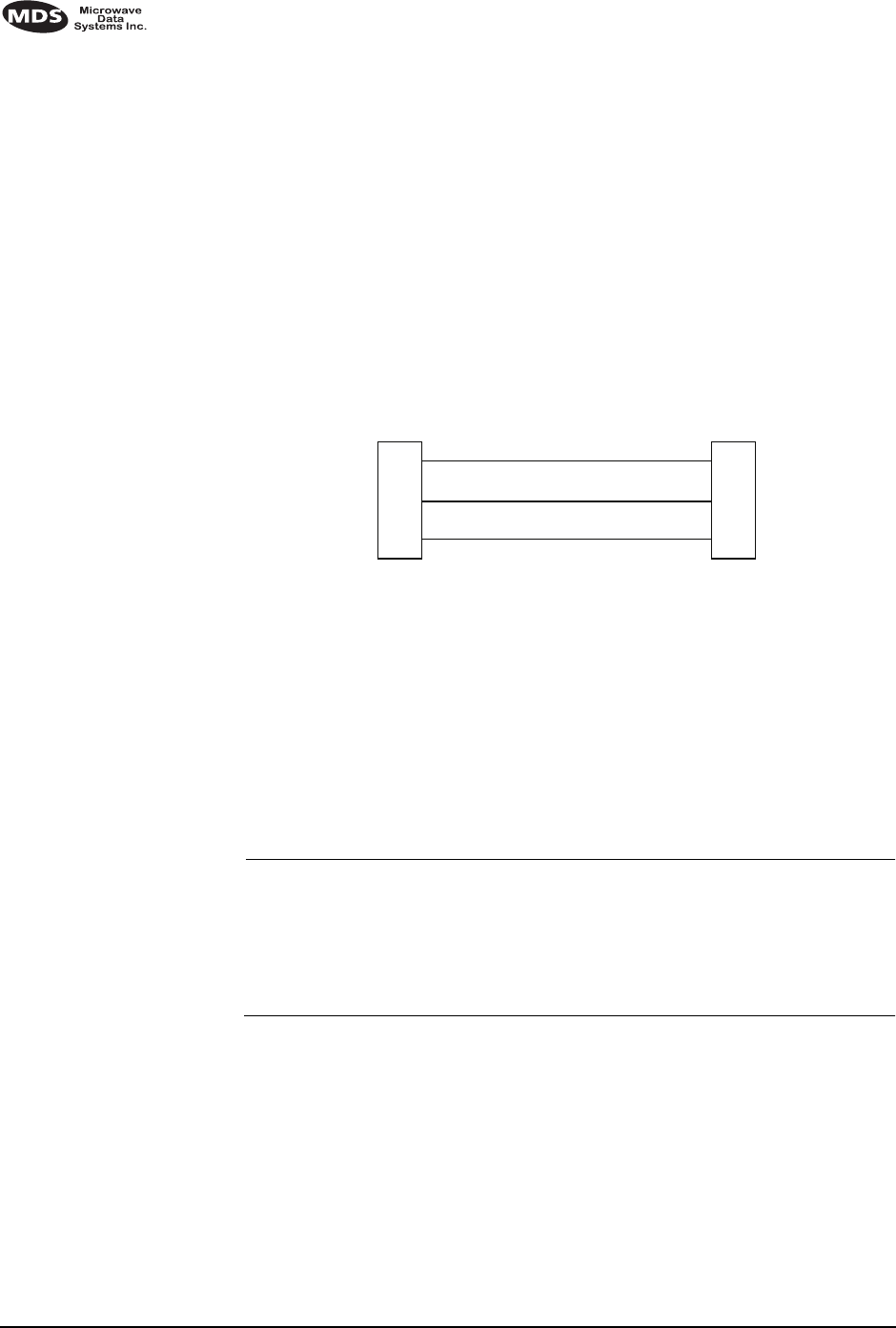
30 OEM Series™ I/O Guide MDS 05-3624A01, Rev. B
Using Radio Configuration Software
If you already have software that you wish to download into the
transceiver, Radio Configuration Software (MDS P/N 03-3649A01)
may be used to perform the installation. (This software is referred to as
“EL705” on the InSite 6.4 or higher CD.) To use this method, proceed
as follows:
1. Connect a PC to the radio’s DATA INTERFACE port via a DB-9 to
DB-25 adapter (MDS P/N 01-3683A01 or equivalent). If desired, an
adapter cable may be constructed from scratch using the wiring
diagram shown in Figure 15.
Invisible place holder
Figure 15. DB-25 to DB-9 Adapter Cable
2. Run the Radio Configuration software. (Click on the opening screen
or press a key to activate the program.)
3. Under the SYSTEM menu, select RADIO SOFTWARE UPGRADE.
Follow the prompts and online instructions to locate the desired
software and complete the upgrade. The radio’s PWR LED flashes
rapidly to confirm that a download is in progress. The download
takes about two minutes.
NOTE: If a software download fails, the radio is left unprogrammed
and inoperative. This is indicated by the PWR LED flashing
slowly (1 second on, 1 second off). This condition is only
likely if a power failure occurred to the computer or radio
during the downloading process. The download can be
attempted again when the fault has been corrected.
2RXD
TXD
GND
2
3
5
DB-9 FEMALE
(TO COMPUTER)
TXD
RXD
GND
3
7
DB-25 MALE
(TO RADIO)

MDS 05-3624A01, Rev. B OEM Series™ I/O Guide 31
6.5 dBm-Watts-Volts Conversion Chart
Table 7 is provided as a convenience for determining the equivalent
wattage or voltage of an RF power expressed in dBm.
Table 7. dBm-Watts-Volts Conversion—for 50 Ohm Systems
dBm V Po
+53 100.0 200W
+50 70.7 100W
+49 64.0 80W
+48 58.0 64W
+47 50.0 50W
+46 44.5 40W
+45 40.0 32W
+44 32.5 25W
+43 32.0 20W
+42 28.0 16W
+41 26.2 12.5W
+40 22.5 10W
+39 20.0 8W
+38 18.0 6.4W
+37 16.0 5W
+36 14.1 4W
+35 12.5 3.2W
+34 11.5 2.5W
+33 10.0 2W
+32 9.0 1.6W
+31 8.0 1.25W
+30 7.10 1.0W
+29 6.40 800mW
+28 5.80 640mW
+27 5.00 500mW
+26 4.45 400mW
+25 4.00 320mW
+24 3.55 250mW
+23 3.20 200mW
+22 2.80 160mW
+21 2.52 125mW
+20 2.25 100mW
+19 2.00 80mW
+18 1.80 64mW
+17 1.60 50mW
+16 1.41 40mW
+15 1.25 32mW
+14 1.15 25mW
+13 1.00 20mW
+12 .90 16mW
+11 .80 12.5mW
+10 .71 10mW
+9 .64 8mW
+8 .58 6.4mW
+7 .500 5mW
+6 .445 4mW
+5 .400 3.2mW
+4 .355 2.5mW
+3 .320 2.0mW
+2 .280 1.6mW
+1 .252 1.25mW
dBm V Po
0 .225 1.0mW
-1 .200 .80mW
-2 .180 .64mW
-3 .160 .50mW
-4 .141 .40mW
-5 .125 .32mW
-6 .115 .25mW
-7 .100 .20mW
-8 .090 .16mW
-9 .080 .125mW
-10 .071 .10mW
-11 .064
-12 .058
-13 .050
-14 .045
-15 .040
-16 .0355
dBm mV Po
-17 31.5
-18 28.5
-19 25.1
-20 22.5 .01mW
-21 20.0
-22 17.9
-23 15.9
-24 14.1
-25 12.8
-26 11.5
-27 10.0
-28 8.9
-29 8.0
-30 7.1 .001mW
-31 6.25
-32 5.8
-33 5.0
-34 4.5
-35 4.0
-36 3.5
-37 3.2
-38 2.85
-39 2.5
-40 2.25 .1µW
-41 2.0
-42 1.8
-43 1.6
-44 1.4
-45 1.25
-46 1.18
-47 1.00
-48 0.90
dBm mV Po
-49 0.80
-50 0.71 .01µW
-51 0.64
-52 0.57
-53 0.50
-54 0.45
-55 0.40
-56 0.351
-57 0.32
-58 0.286
-59 0.251
-60 0.225 .001µW
-61 0.200
-62 0.180
-63 0.160
-64 0.141
dBm µV Po
-65 128
-66 115
-67 100
-68 90
-69 80
-70 71 .1nW
-71 65
-72 58
-73 50
-74 45
-75 40
-76 35
-77 32
-78 29
-79 25
-80 22.5 .01nW
-81 20.0
-82 18.0
-83 16.0
-84 11.1
-85 12.9
-86 11.5
-87 10.0
-88 9.0
-89 8.0
-90 7.1 .001nW
-91 6.1
-92 5.75
-93 5.0
-94 4.5
-95 4.0
-96 3.51
-97 3.2
dBm µV Po
-98 2.9
-99 2.51
-100 2.25 .1pW
-101 2.0
-102 1.8
-103 1.6
-104 1.41
-105 1.27
-106 1.18
dBm nV Po
-107 1000
-108 900
-109 800
-110 710 .01pW
-111 640
-112 580
-113 500
-114 450
-115 400
-116 355
-117 325
-118 285
-119 251
-120 225 .001pW
-121 200
-122 180
-123 160
-124 141
-125 128
-126 117
-127 100
-128 90
-129 80 .1ƒW
-130 71
-131 61
-132 58
-133 50
-134 45
-135 40
-136 35
-137 33
-138 29
-139 25
-140 23 .01ƒW

32 OEM Series™ I/O Guide MDS 05-3624A01, Rev. B
7.0 GLOSSARY OF TERMS
If you are new to digital radio systems, some of the terms used in this
guide may be unfamiliar. The following glossary explains many of these
terms and is helpful in understanding the operation of the transceiver.
Antenna System Gain—A figure, normally expressed in dB,
representing the power increase resulting from the use of a gain-type
antenna. System losses (from the feedline and coaxial connectors, for
example) are subtracted from this figure to calculate the total antenna
system gain.
Bit—The smallest unit of digital data, often represented by a one or a
zero. Eight bits (plus start, stop, and parity bits) usually comprise a byte.
Bits-per-second—See BPS.
BPS—Bits-per-second. A measure of the information transfer rate of
digital data across a communication channel.
Byte—A string of digital data usually made up of eight data bits and
start, stop and parity bits.
Data Circuit-terminating Equipment—See DCE.
Data Communications Equipment—See DCE.
Data Terminal Equipment—See DTE.
dBi—Decibels referenced to an “ideal” isotropic radiator in free space.
Frequently used to express antenna gain.
dBm—Decibels referenced to one milliwatt. An absolute unit used to
measure signal power, as in transmitter power output, or received signal
strength.
DCE—Data Circuit-terminating Equipment (or Data Communications
Equipment). In data communications terminology, this is the “modem”
side of a computer-to-modem connection. The MDS OEM Series™ is a
DCE device.
Decibel (dB)—A measure computed from the ratio between two signal
levels. Frequently used to express the gain (or loss) of a system.
DTE—Data Terminal Equipment. A device that provides data in the
form of digital signals at its output. Connects to the DCE device.

MDS 05-3624A01, Rev. B OEM Series™ I/O Guide 33
Fade Margin—The greatest tolerable reduction in average received
signal strength that is anticipated under most conditions. Provides an
allowance for reduced signal strength due to multipath, slight antenna
movement, or changing atmospheric losses. A fade margin of 20 is
usually sufficient in most systems.
Hardware Flow Control—A transceiver feature used to prevent data
buffer overruns when handling high-speed data from the RTU or PLC.
When the buffer approaches overflow, the radio drops the clear-to-send
(CTS) line, which instructs the RTU or PLC to delay further
transmission until CTS again returns to the high state.
Host Computer—The computer installed at the master station site,
which controls the collection of data from one or more remote sites.
Latency—The delay (usually expressed in milliseconds) between when
data is applied to TXD (Pin 2) at one radio, until it appears at RXD
(Pin 3) at the other radio.
MAS—Multiple Address System. A radio system where a central
master station communicates with several remote stations for the
purpose of gathering telemetry data.
Master (Station)—Radio which is connected to the host computer. It is
the point at which polling enters the network.
Multiple Address System—See MAS.
PLC—Programmable Logic Controller. A dedicated microprocessor
configured for a specific application with discrete inputs and outputs. It
can serve as a host or as an RTU.
Point-to-Multipoint System—A radio communications network or
system designed with a central control station that exchanges data with
a number of remote locations equipped with terminal equipment.
Poll—A request for data issued from the host computer (or master PLC)
to a remote radio.
Programmable Logic Controller—See PLC.
Received Signal Strength Indication—See RSSI.
Redundant Operation—A station arrangement where two transceivers
and two power supplies are available for operation, with automatic
switchover in case of a failure.
Remote (Station)—A radio in a network that communicates with an
associated master station.
Remote Terminal Unit—See RTU.

34 OEM Series™ I/O Guide MDS 05-3624A01, Rev. B
RSSI—Received Signal Strength Indication. A measure, in dBm, of the
strength of the signal received by a radio from an antenna. The radio
must be properly calibrated for the RSSI value to be meaningful.
RTU—Remote Terminal Unit. A data collection device installed at a
remote radio site.
SCADA—Supervisory Control And Data Acquisition. An overall term
for the functions commonly provided through an MAS radio system.
Supervisory Control And Data Acquisition—See SCADA.

MDS 05-3624A01, Rev. B OEM Series™ I/O Guide I-1
INDEX
A
ACCESS DENIED error message 17
Accessories 5
Accessory power adapter 5
Accessory Power pinout (Pin 18) 12
Adapters
accessory power adapter 5
DB-9 to DB-25 5
PC programming adapter kit 5
Alarms
alarm code definitions 25
major vs. minor 25
pinout (Pin 25) 12
using STAT command to display 22
AMASK command 18
Antenna
installation 6
RSSI command used to refine heading 13
system gain, defined 32
Yagi, illustrated 9
Applications 2
Multiple Address Systems (MAS) 2
point-to-multipoint system 2
point-to-point system 3
Auto-Open, pinout (Pin 23) 12
B
BAUD command 19
Bench testing (radio performance) 27–28
Bit, defined 32
Bits-per-second. See BPS
BPS (bits-per-second), defined 32
Byte, defined 32
C
Cable, loss due to length of coaxial 10
COMMAND FAILED error message 16
Command summary, table 17
Commands
AMASK (set/display alarm triggers) 18
BAUD (set/display rate, encoding) 19
CTS (set/display CTS line response timer) 19
descriptions 18
DEVICE (set/display radio behavior) 20
DKEY (deactivate transmitter after KEY command) 20
entering on terminal interface 16
INIT (reinitialize radio to factory defaults) 20
KEY (activate transmitter) 21
OWM (set/display owner’s message) 21
OWN (set/display owner’s name) 21
PWR (set/display RF forward output power) 21
RSSI (display RSSI) 22
RX (set/display receive frequency) 22
RXTOT (set/display receive time-out timer value) 22
SER (display radio serial number 22
SREV (display software revision level) 22
STAT (display current alarm status) 22
terminal interface 16
TOT (set/display time-out value and timer status) 23
TX (set/display transmit frequency) 23
Connections to radio, illustrated 6
Conversions, dBm-Watts-Volts 31
CTS command 19
CTS pinout (Pin 5) 11
D
Data interface
connector pinouts 11
installing connection 10
specifications 27
dB. See Decibel 32
DB-9 to DB-25 adapter 5
illustrated 16, 30
dBi, defined 32
dBm, defined 32
DCD
pinout (Pin 8) 11
DCD LED
description 13
DCE (Data Cirtuit-terminating Equipment), defined 32
Decibel (dB), defined 32
Description, product 1
DEVICE command 20
Diagnostic Channel Enable, pinout (Pin 23) 12
Diagnostics
interface specifications 27
Differences among models 1
Display
alarm status (STAT command) 22
alarm triggers (AMASK command) 18
baud rate and encoding (BAUD command) 19
CTS line response timer (CTS command) 19
owner’s message (OWM command) 21
owner’s name (OWN command) 21
radio behavior (DEVICE command) 20
radio serial number (SER command) 22
receive frequency (RX command) 22
receive time-out timer value (RXTOT command) 22
RF forward output power (PWR command) 21
RSSI (RSSI command) 22
software revision level (SREV command) 22
time-out value and timer status (TOT command) 23
transmit frequency (TX command) 23
DKEY command 20
Downloading new software 29
DSR pinout (Pin 6) 11
DTE (Data Terminal Equipment), defined 32

MDS 05-3624A01, Rev. B OEM Series™ I/O Guide I-2
E
EEPROM FAILURE error message 17
Enable/disable
diagnostic channel, pinout (Pin 23) 12
Environment specifications 26
Error messages 16
access denied 17
command failed 16
EEPROM failure 17
incorrect entry 16
not available 16
not programmed 16
text too long 16
unknown command 16
F
Fade margin, defined 33
Feedlines 9
Filter, helical, adjustment 28
Frequency
adjusting helical filter when changed 28
setting. See TX and RX commands
G
Glossary 32
Ground
protective (Pin 1) 11
signal (Pin 7) 11
H
Half-duplex 3
switched carrier operation 4
Hand-Held Terminal (HHT) 5
Hardware flow control, defined 33
Helical filter
adjusting 28
locations, illustrated 29
Host computer, defined 33
I
Illustrations
antenna, Yagi 9
board version 1
connections to radio 6
DB-25 to DB-9 adapter cable 16, 30
helical filter locations 29
MDS OEM Series™ model number codes 4
point-to-point link 3
terminal interface connected to transceiver 15
transceiver mounting dimensions, enclosed version 8
INCORRECT ENTRY error message 16
INIT command 20
Installation 6–12
antenna 6
configuring transceiver 7
DATA INTERFACE connection 7
data interface connections 10
power 6
power connection 10
steps 6
K
KEY command 21
Keying
on data (DKEY command) 20
switched carrier operation 4
switched carrier, defined 4
L
Latency, defined 33
LEDs
DCD 13
indicators, described 13
PWR 13
RXD 13
RXD, Pin 3 11
status indicators, illustrated 13
TXD 13
TXD, Pin 2 11
Loss. See Signal
M
MAS (Multiple Address System) 2
defined 33
Master Station
defined 33
keying behavior 4
Model number codes 4
MDS OEM Series™, illustrated 4
Models
system specifications 26
N
NOT AVAILABLE error message 16
NOT PROGRAMMED error message 16
O
Operation 13
environment, specifications for 26
Output, 5.8 Vdc regulated, pinout (Pin 19) 12
OWM command 21
OWN command 21
Owner’s message, set/display. See OWM command
Owner’s name, set/display. See OWN command
P
PC Programming Adapter Kit 5
Performance
testing 27–28
Pinouts on data interface 11
PLC (Programmable Logic Controller), defined 33
Point-to-multipoint
defined 33
system 2
Point-to-point
link, illustrated 3
system 3

MDS 05-3624A01, Rev. B OEM Series™ I/O Guide I-3
Poll, defined 33
Power
connection 10
installing 6
LED status indicator (PWR LED) 13
RF, chart for converting dBm-Watts-Volts 31
Power attenuators, use of in testing 28
Primary power
specifications 27
Procedures
checking for alarms (STAT command) 24
connecting terminal interface 14
downloading new software 29
entering commands using a terminal interface 16
helical filter adjustment 28
installation 6
operation 13
performance optimization 13
reading LED status indicators 13
troubleshooting 24
Product
accessories 5
description 1
display radio serial number (SER command) 22
model number codes 4
Programming, transceiver 14–17
PWR
command 21
PWR LED
description 13
R
Radio
configuration software 5, 29
serial number, displaying (SER command) 22
Radio type
system specifications 26
Receive Audio Output pinout (Pin 11) 11
Received signal strength indication See RSSI 34
Receiver
specifications 27
Redundant operation, defined 33
Remote
Station, defined 33
Resetting
transceiver (INIT command) 20
Revision level
display software (SREV command) 22
RSSI
adjusting helical filter for increased signal strength 28
command 22
command, used to refine antenna heading 13
defined 34
RTS pinout (Pin 4) 11
RTU (Remote Terminal Unit)
defined 34
RTU simulator 5, 28
RX command 22
RXD LED
description 13
Pin 3 11
RXTOT command 22
S
SCADA (Supervisory Control And Data Acquisition),
defined 34
SER command 22
Set
alarm triggers (AMASK command) 18
receive time-out timer value (RXTOT command) 22
Signal
ground (Pin 7) 11
loss due to coaxial cable length, table 10
Simplex 3
single-frequency operation 4
special case of switched carrier operation 4
Software
control from PC 29
display revision level 22
upgrades (.S28 files) 29
upgrading 29
Specifications
data interface 27
diagnostics interface 27
environment 26
models 26
primary power 27
radio type 26
receiver 27
transceiver 26–27
transmitter 26
SREV command 22
STAT command 22
Switched carrier operation 4
T
Tables
accessories 5
alarm code definitions 25
command summary 17
conversions, dBm-Watts-Volts 31
data interface connector pinouts 11
LED status indicators 13
length vs. loss in coaxial cables 10
Technical reference 26–31
bench test setup 27
Terminal Interface
connected to transceiver, illustrated 15
connection and startup 14
entering commands 16
error messages displayed on 16
keyboard commands 16
Testing. See bench testing
TEXT TOO LONG error message 16
Timer, set/display time-out value and status (TOT
command) 23
TOT command 23
Transceiver
applications 2
board version, illustrated 1
configuring for operation 7
dimensions, mounting enclosed version, illustrated 8
mounting 6
mounting board version 8
mounting enclosed version 8
programming 14–17

MDS 05-3624A01, Rev. B OEM Series™ I/O Guide I-4
specifications 26–27
upgrading software 29
Transmitter
specifications 26
Troubleshooting 24–25
connecting terminal interface for displaying alarm
codes 14
STAT command (Status) 24
TX command 23
TXD LED
description 13
Pin 2 11
U
UNKNOWN COMMAND error message 16
Upgrading software 29

IN CASE OF DIFFICULTY...
MDS products are designed for long life and trouble-free operation. However, this equipment, as
with all electronic equipment may have an occasional component failure. The following informa-
tion will assist you in the event that servicing becomes necessary.
FACTORY TECHNICAL ASSISTANCE
Technical assistance for MDS products is available from our Customer Support Team during
business hours (8:00 A.M.–5:30 P.M. Eastern Time). When calling, please give the complete
model number of the radio, along with a description of the trouble symptom(s) that you are expe-
riencing. In many cases, problems can be resolved over the telephone, without the need for
returning the unit to the factory.
Please use the following telephone numbers for product assistance:
716-242-9600 (Phone)
716-242-9620 (Fax)
FACTORY REPAIRS
Component-level repair of radio equipment is not recommended in the field. Many components
are installed using surface mount technology, which requires specialized training and equipment
for proper servicing. For this reason, the equipment should be returned to the factory for any PC
board repairs. The factory is best equipped to diagnose, repair and align your radio to its proper
operating specifications.
If return of the equipment is necessary, you will be issued a Returned Material Authorization
(RMA) number. The RMA number will help expedite the repair so that the equipment can be
repaired and returned to you as quickly as possible. Please be sure to include the RMA number
on the outside of the shipping box, and on any correspondence relating to the repair. No equipment
will be accepted for repair without an RMA number.
A statement should accompany the radio describing, in detail, the trouble symptom(s), and a
description of any associated equipment normally connected to the radio. It is also important to
include the name and telephone number of a person in your organization who can be contacted if
additional information is required.
The radio must be properly packed for return to the factory. The original shipping container and
packaging materials should be used whenever possible. All factory returns should be addressed to:
When repairs have been completed, the equipment will be returned to you by the same shipping
method used to send it to the factory. Please specify if you wish to make different shipping
arrangements.
Microwave Data Systems Inc.
Customer Service Department
(RMA No. XXXX)
175 Science Parkway
Rochester, NY 14620 USA
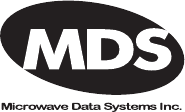
175 Science Parkway, Rochester, New York 14620
General Business: +1 (716) 242-9600
FAX: +1 (716) 242-9620
Web: www.microwavedata.com
